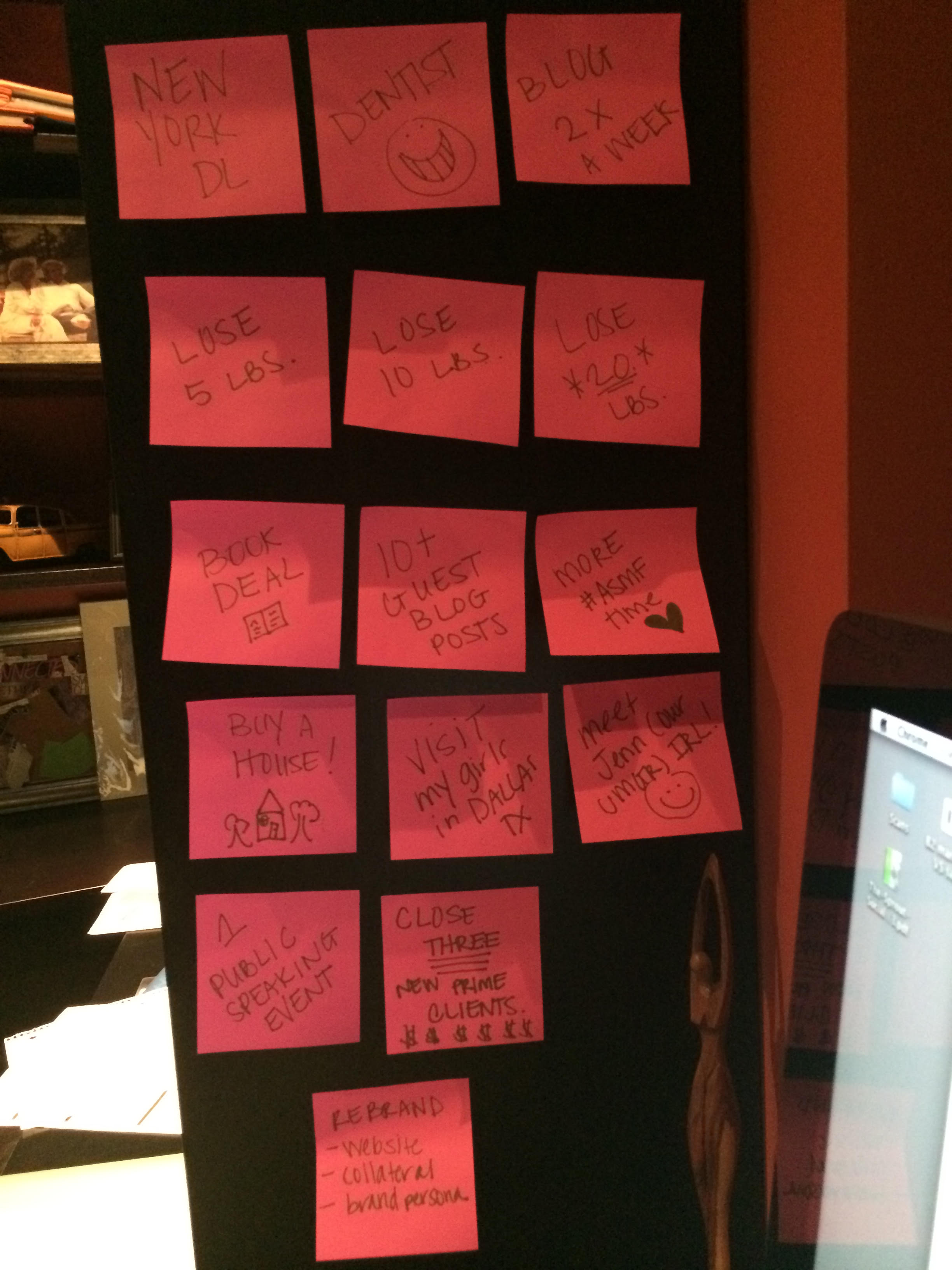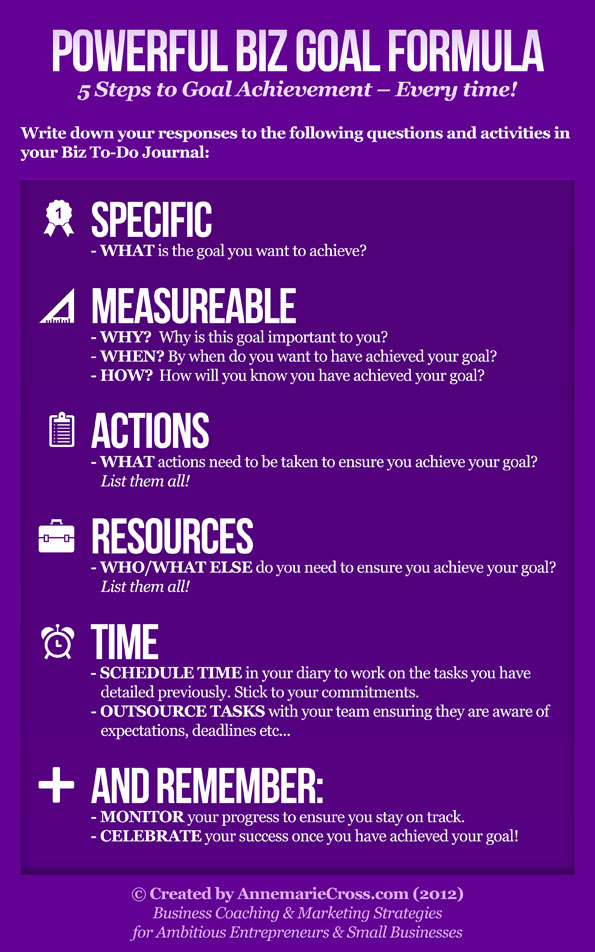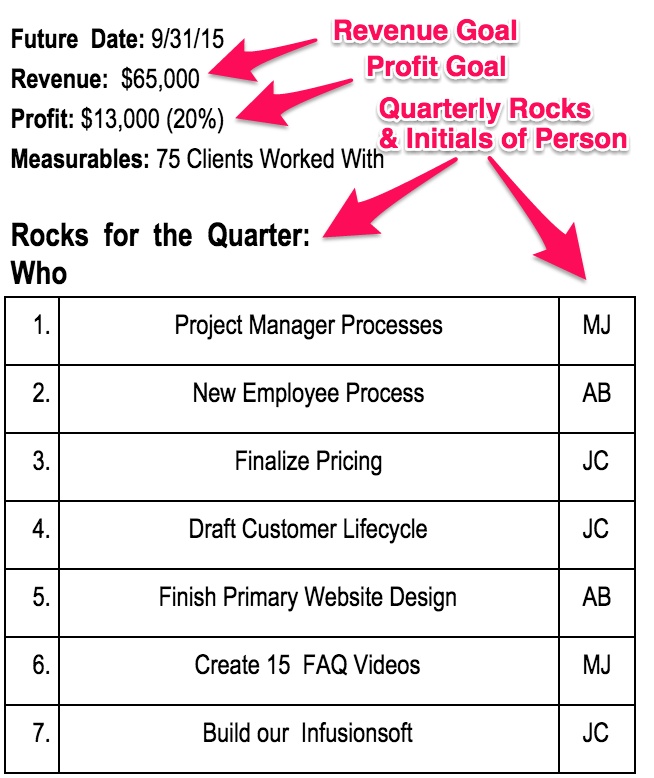
“Our goals can only be reached through a vehicle of a plan, in which we must fervently believe, and upon which we must vigorously act. There is no other route to success.” ~Pablo Picasso
You are upset.
Because lately you have been working REALLY hard…
…but all your effort and sweat seem to be in total VAIN.
There is still a BIG GAP between where you are NOW and where you want to BE.
You can`t seem to understand why people around you are crushing their goals.
Because they are…
NOT smarter than you…
NOT more hard-working than you…
NOT more passionate than you.
Can you relate?
If so, no worries. I`ve been there too.
Relax, I got your back.
So for this important topic, I had to bring in help from some of the best experts in their respected fields.
As you probably have guessed from the headline, 117 experts will share their wisdom with you.
Yes, you read correct, I said 117.
I asked them the following question:
What is your best tip on how to set goals that you use in your business?
Note: this is definitely one of the best collections of expert goal setting tips out there. When you see the contributors on this post, you will understand why.
If you don`t agree, send me an email and I will take my next ride on a polar bear…WITHOUT a viking helmet.
This post is over 21 000 words and you should bookmark this page for future reference.
Note: Do you want this post with the 117 awesome experts as a PDF file?
Click on the image below to get the PDF file + your FREE 7-Days Course “How To Crush Your Goals” showing you a step-by-step system to set and achieve your goals.
If I were to give a proper introduction of all of the experts with all of their merits, the list of their achievements alone would surpass 21 000 words by far. I would definitely advise you to check out every single one of the experts.
Without further ado, here are the experts…
(Click on the links below to go directly to the experts.)
Jeffrey Gitomer | Jeff Bullas | Evan Carmichael | Steve Pavlina | Joel Brown | Jaime Tardy
John Lee Dumas | Gideon Shalwick | Ian Cleary | Steven Aitchison
Michael Maidens | AJ Vaynerchuk | Dino Dogan | Ana Hoffman | Scott Eddy
Mark Ellwood | Mark Schaefer | Skip Prichard | James Dyson | Ted Rubin
Erin Falconer | Mike Vardy | Greg Hickman | Todd R.Tresidder | Jennifer Gresham
Terri Trespicio | Mike Allton | Brooke Ballard | Thanh Pham | Jennifer Gluckow
Annemarie Cross | Mark Shead | Ramsay Taplin | Josh Coffy | Pauline Cabrera
Paula Rizzo | Ebong Eka | Brittany Bullen | Nick Loper | Martina McGowan
Adrienne Smith | Jenny Powers | Timo Kiander | Ashley Faulkes | Dustin W. Stout
Tanya Smith | Adam Connell | Sue Anne Dunlevie | Jenna Dalton | Sara Arrow
Don Purdum | Adam Binder | Ron Sela | Tim Soulo | Erik Emanuelli
Ryan Biddulph | Ileane Smith | Jaime Buckley | Ricky Figueroa | Stuart Walker
Andrea Beltrami | Anthony Metivier | Eddie Gear | Joseph Pitcher | Thai Nguyen
Dennis Seymour | Dan R. Morris | David Leonhardt | Trevor McKendrick | Dave Schneider
Carol Amato | Sonia Thompson | Ruth King | Brent Jones | Kevin Duncan
Rick Ramos | Peter Banerjea | Matthew Loomis | Jason Will | Brandon Yanofsky
| Lauren Tharp | Codrut Turcanu | Christian Karasiewicz | Andrew Warner | Paul Minors
Elna Cain | Josh Rasmussen | Kayla Matthews | Matthew Capala | Erlend Bakke
Sharon Hurley Hall | Gail Gardner | Rohan Gilkes | Amber Hurdle | John Rampton
Roxana Nasoi | Mike Leigh | Douglas Lim | Natasha Vorompiova | Uttoran Sen
Andréa Jones | Samar Owais | Devesh Sharma | Brian Young | Pooja Lohana
Deborah Anderson | Zachary Sexton | Lisa Sicard | Jason Quey | Daniela Uslan
Kenny Andam | Jane Tabachnick | Sylviane Nuccio | Paul Back | Matt Banner
Nathan Ambrose | Bindesh Rach
Jeffrey Gitomer from Gitomer

“Goals are harder to write than achieve.
It would seem obvious that the biggest part of goal setting is writing them down, but in fact, it’s the most difficult part of the process.
Most people, cannot define their thoughts into words. Something as simple as a new car might leave someone so baffled that they simply hang a picture of the car they want on the wall – they forget the most important part – how they expect to, and how they intend to, achieve the goal and get the car.
As a writer, defining my goals has always been easy, and in fact, I am going to offer this one tip that will help significantly:
Write the goal twice.
Once in three or four words, and once with full description. Put the three or four words on a post-it note on your bathroom mirror and write the full description some place where you can easily track it. Probably the easiest place would be excel, or some spreadsheet.
Seeing your goal written down every day, or twice a day on your bathroom mirror, will continue to feed your mind with ideas on how you can achieve it and the more you document them and your spreadsheet, the more likely it is that goal achievement will be yours.”
Jeffrey Gitomer,
Author of The Little Red Book of Selling
©2015 Jeffrey Gitomer
Jeff Bullas from Jeff Bullas

“The goals need to be able to answer these two questions. Are they congruent with my true purpose in life? That means that they will match my innate abilities and passions. This means that achieving the goals won’t seem like work but play. If they don’t meet that criteria then I outsource.
Next. What goals will I focus on to produce the best results with the least amount of effort? I don’t know whether I ask that question because I am lazy or just human. I will let you decide.
But the “Pareto Principle” just makes sense to me”
Evan Carmichael from Evan Carmichael

“Don`t be afraid to change your goals.
I find that quite often people will set a goal and then they`ll start working towards it, and then they´ll stop.
One of the big reasons is because they are no longer passion about that goal that they have set for themselves. And that`s okay. That`s normal. That`s human nature.
You are not going to be the same person always and as you start something you may discover that it`s not what actually what you want to do.
As you learn more about yourself and you start working on it, you may need to change your goal. Don’t be afraid to change your goal if it`s NOT something that you aren’t excited about anymore.
I see too many people who are associated with the corporate environment, people who have graduated and they kind of always wanted to start a business, but they don`t have the guts to do or they are telling themselves stories why they can`t do it.
So they set corporate goals for themselves, “I want to reach this and become VP and then CEO”. You stick on this path that isn`t really what excites you and motivates you to keep going.
I would do a gut-check at least once a week on your big goals. The little goals are great, you should hopefully be able to accomplish them within a week.
Look at your big goals once a week and do a gut-check to see if this is something that still motivates me. Do I look at that goal and say: “I`m inspired you to get up every morning”…
or do you say: “Ohhh, I don’t really feel like it. I`m not feeling that goal anymore.” Because if that is where you are, then you need to switch your goal to do something that you are more passionate about.”
Steve Pavlina from Steve Pavlina

“My tip would be to largely ignore people, companies, services, and organizations who try to get you to put their goals ahead of your own, unless there’s a strong synergy between your goals and theirs. You’ll find no shortage of people who’d love to see you prioritize their goals ahead of your own.”
Joel Brown from Addicted2Success

“When setting goals for my business I like to focus on the outcome I desire, that way I know that I have hit my goal for sure when I eventually get there. When setting goals I have a clear view of the big end vision, but not a complete understanding because I haven’t experienced the journey of pursuing the goal yet.
When setting out to accomplish your goals it is a great idea to “chunk” your way through it. What I mean by this, is looking at each step, piece by piece at a time and hacking away at it. If someone asked you to build the Golden Gate Bridge, you would scare yourself out of doing it if you focused on the incredible size of the end creation. The best way to work your way through a HUGE goal is to chunk it, one piece at a time, day by day, week by week, month by month and you will eventually build the incredible vision you’ve set out to achieve.
Also, you should tie your Values to your goals. Your Values are your WHY, your actions are you HOW and your goal is your WHAT. A lot of people work from the outside in and wonder why they lose momentum. Working from the inside out towards your goal is much more effective.”
Jaime Tardy from Eventual Millionaire

“I set a yearly goal broken into monthly and daily objectives. Then I post it EVERYWHERE. I even have IFTTT send me a text message with my goal every single morning. My first actions each day are what I call “Active” actions – they have to align with that number one goal AND push me outside of my comfort zone a bit. That’s how you make fast progress! :)”
John Lee Dumas from Entrepreneur On Fire

“If you are looking to set goals, you MUST be SMART about it. In TheFreedomJournal.com, I go over in detail show to set Specific, Measurable, Attainable, Relevant, and Timely Goals. Then, I guide your through the process of accomplishing that goal in 100-days. Afterwards, you’ll be prepared to IGNITE!”
Gideon Shalwick from Splasheo and Veeroll

“I draw pictures.
For each goal, I draw two pictures.
On the left, I draw a picture of the “current reality” for that particular goal.
On the right, I draw a picture of the “future reality” for that same goal.
Then, I connect the two sides up with big fat arrows with text inside of them. The text inside these arrows are the tasks I need to do, to be able to go from my current reality to my future reality for that particular goal. Just like in the picture below…

Works like a charm.
I learnt this from Patti Dobrowolski on a Tedx Talk, but modified it a little for my own use. Instead of drawing out my WHOLE future, I just create a NEW picture for EACH new goal. Makes it a lot easier to handle mentally… and graphically! Patti’s amazing talk can be seen here https://www.youtube.com/watch?v=A7KRSCyLqc4 ”
Ian Cleary from Razor Social

“I create three goals every quarter, print them out and put them up my wall. Every day I look at the goals to see if we are making progress on them.
Don’t make your goals too complicated. Pick three that are really important for your business and work on them every single day.
It’s amazing the momentum you can pick up if you’re making progress every day!”
Steven Aitchison from Steven Aitchison

“My very best tip for setting goals in your business is to have a coach who can hold you accountable
to the goals you are setting for yourself. Having someone who is more knowledgable than you in
your niche, and having them be your coach is amazing in so many ways, but the very fact that you are
held accountable to the goals you set for yourself is so much better than trying to do it on your own: Your
motivation is higher, your level of committment is higher, and your shared knowledge is much higher as well.”
Michael Maidens from Michael Maidens

“One of the biggest struggles for me personally is to set a goal that really gets me excited. In the past these were either opportunities or financially focussed goals.
While these are both hugely important I feel that I have both evolved beyond these personally and as a business.
For me now these two aspects are an outcome of a greater goal.
When I set my goals now I focus on Impact and Purpose. I set my goals thinking about the people’s lives that will be impacted by the achievement of the goal and my greater purpose while hanging out in this planet.
So, my suggestion is to think big, make a huge impact in the lives of many people and live with purpose. The money and opportunity will from from that.”
AJ Vaynerchuk from Vayner Media

“#1 tip:
Create accountability. If there isn’t accountability, there won’t be the incentive to see through your goals. That goes for yourself or if you assign a goal for others!”
Dino Dogan from Dino Dogan

“The most important lesson I had to learn the hard way about setting goals is that you can never be too specific when it comes to clarity of vision.
Stating “I want to be wealthy” as a goal is not the same as stating “I want to own 5 multi family rentals in 3 years and make mostly passive income from it”.
The first statement gives you a vague notion that at some point in future you’d like to have some vague amount of money.
The second statement is not only clear but also instructive. It tells me that I have to purchase 1-2 rental properties per year and if I don’t own at least 3 rentals by the end of year 2, I know I’m falling behind and I can course-correct as needed.
So, the best tip on how to set goals that I use in my business is to very explicit about the goal. I hope this will serve as a timely reminder for us all.”
Ana Hoffman from Traffic Generation Cafe

“Big dreams are great, but it’s the small every-day goals that get you motivated, get you going, and get things done.
So my best advice is to break down your reach-for-the-stars goals into small bite-sized mini-goals you can achieve TODAY.
For instance, if your goal is to create a video course, your goal for the day might to get an outline for the first video done.
Achievable everyday goals help you achieve your dreams – one step at a time.”
Scott Eddy from Mr Scott Eddy

“Setting goals these days is quite different than it used to be…. Now we can get help from others to make us accountable. If you really want to reach a goal, throw it out there on social, make your friends and family track your progress, you will be surprised how many ‘cheerleaders’ you have in your life.”
Mark Ellwood from Get More Done

“When you set a major goal, set a deadline for it. Without an end point in mind, you give yourself excuses to delay. Instead, set a date to accomplish what you want, whether it’s for the next day, next month, or next year. Then, work backwards from your goal to figure out what you need to do at each step of the way. Each step becomes a project. And each project has things you have to do each day. Write those things down on your to-do list and you’ll be on your way to achieving your goals.”
Mark Schaefer from Business Grow

“I feel strongly that we need some over-arching goals but in this rapidly-changing world we need to adopt a “liquid” strategy that is flexible enough to respond to changing conditions. In fact, I think it is essential to be constantly monitoring the environment for both threats and opportunities. The ability to rapidly assess and respond to changes is a new business life skill!”
Mark Schaefer is a college educator, marketing consultant, and author of five social media marketing books including The Content Code.
Skip Prichard from Skip Prichard

“My best tip on setting goals to use in business is to collaborate. A goal set from the CEO and foisted on the organization is a goal destined to fail. Instead, a leader should inspire a team with a vision and then let that team jointly agree on the milestones necessary to reach it. After the goal is set, it’s imperative to measure progress, celebrate success, fail quickly, rethink old methods, and brainstorm ways to increase everyone’s productivity. When an aggressive team goal is coupled with an inspiring vision, reaching it becomes something that every member of the team will remember as a career highlight.”
James Dyson from Optimize Press

What is your best tip on how to set goals that you use in your business?
“Many people make the mistake of trying to plan long-term goals 6 months, 1 year, 2 years away, but there are so many variables that can change in this time it is very hard to measure how well you are working towards these goals.
In our business, we work towards 60 or 90 day goals, but we break these larger goals down into micro-goals which can be accomplished in 1-2 weeks. We then use the SCRUM methodology to manage these micro-goals (which become tasks within our SCRUM framework) and setup 2 week “sprints” where we work towards these specific micro-goals which each have a measurable outcome.
By working in this way, our output and results are far more measurable and focused, and by ensuring our team focus only on the tasks set out in each sprint, we ensure all actions contribute towards our overall goals.
Working in shorter sprints also ensures that we have a solid feedback-loop and we can adjust and adapt to any situations that may arise more quickly and efficiently.”
~ James Dyson, OptimizePress Founder
Ted Rubin from Ted Rubin

“The bottom line is really your mindset and how you approach your business and life, in the first place. In order to set goals, and accomplish them, you need to have control over certain important controllable aspects of daily life.
There are so many things in life that we simply cannot control, but what about the things we CAN control? As human beings, we have the power of reasoning and choice, both of which give us substantial control over our own life situations… we just need to be reminded of this from time to time. Following is my reminder list of Things We All Control that will keep you focused and allow you to focus on your business goals.
1. Acting: I am referring here to “acting” as our ability to take action.
2. Attitude: You can’t control someone else’s attitude, but you can control your own.
3. Commitment: Commitment involves your heart, which only you can control.
4. Empathy: Will you try to first understand, or to be understood?
5. Focus: You get to control what you pay attention to, where you put your focus.
6. Friendship: This is about our personal decision to be a friend.
7. Listening: You can control if you will listen to someone, then how you will listen.
8. Hearing: Hearing, to me, is what you do when you take listening one level further and involve your heart and understanding.
9. Learning: Learning happens inside your own mind, and although others may influence it, you still control how open you are to taking in new information and integrating it with your work and life.
10. Love: You might think you cannot control love, but what you do with your heart cannot be decided by anyone else.
11. Motivation: Motivation is about what entices someone. To motivate others, you first need to know their needs, preferences, passions, and even their pain points, so you can offer an incentive (reward) that is completely relevant and valuable to THEM.
12. Mood: This one can be difficult to control, but it is still possible. If someone “makes” you angry, it is because you let them get under your skin, not because they had the power to choose your mood for you.
Control these aspects, wrap your arms around the importance of your “mindset,” and setting and reaching your goals will become second nature. #NoLetUp!”
Erin Falconer from Pick The Brain

“The ability to set goals is quintessential to your success. In my experience, in order to actually achieve these goals you must break them down into two buckets: The Ultimate Goal, The Micro Goals. The ultimate goal is where you want to be in a larger sense – this is what success would look like if you could achieve this goal. Obviously, you’re not going anywhere without having that larger ‘destination.’ The micro goals, however, are perhaps the most important part of the equation – it’s the road map aka the small benchmarks that will ultimately take you to your final destination. Breaking up your larger goal into smaller, manageable micro goals that are easier to reach and provide motivation all along the way is the key to getting the job done.
Oh, and WRITE IT DOWN. Goals in your head vs. goals on paper (that you are accountable for) make all the difference.”
Mike Vardy from Productivityist

“I start planning the year in September of the previous year, and I theme my months based on my overarching plans/goals for the year. I don’t theme every month – 9-10 of them – but by having an overarching theme for the rest of the months I can easily pinpoint where I need to spend the majority of my time to move closer to my goal.
When I theme my months I simply create an all-day event that I’m left available for in GCal (you can do this in Outlook too). I make it red so it stands out and I have the “event” last for the duration of the month. I also make it repeat so all I need to do is alter the name of the theme the next year. (By the way, the months I usually leave unthemed are July and August because the kids are home for those months from school and January because I spend that month in “Reflection/Renewal” Mode.)
Want to read more about my Yearly Preview process? Click here.”
Greg Hickman from System.ly

“I think people confuse goals, with strategy, objectives and tactics. So let’s get on the same page.
I believe goals are broad statements of what we or an organization hopes to achieve and are qualitative in nature. Although an organization can have short-term and long-term goals, it is important that each goal is clear and can be supported by measurable objectives. Goals should drive your strategic planning preparation.
Goals supported by measurable objectives become self-fulfilling. What’s more, strategic plans with four to seven overarching goals to be achieved within three to five years are the most efficient to manage.
Very often, goals give further definition to the organization’s vision.
Once I have a goal, I define objectives.
Objectives are the most critical component of the strategic plan, as they answer the questions, “How much? By when?” They are what drive strategy development.
Objectives are quantitative in nature. In fact, objectives are the only quantifiable elements of the strategic plan. Goals, strategies and tactics are all qualitative and describe how things get done, but not how much will be accomplished.
To keep your objectives on track, a good rule of thumb is that every objective should begin with the word “increase” or “decrease.” After all, objectives define how much improvement will take place, and that improvement is either in the form of increasing a statistic (volume) or decreasing a statistic (errors). If you are simply trying to maintain a statistic, it doesn’t belong in the strategic plan; it is better suited as a key performance indicator or for the balanced scorecard.
So my tip? Well, pick ONE key metric for each objective that will be your guiding star on whether you’re completing your objective and/or closer to reaching your goal.”
Todd R.Tresidder from Financial Mentor

“Goal setting is not a set-it-and-forget-it process. Instead, goal setting done right is iterative. I set my goals at the beginning of each year and I review them at least once per month to maintain front of the mind awareness. As new goals rise to the top they are added to the list, and as old goals are achieved or deemed no longer relevant, they’re removed. This keeps my goals fresh, relevant, and in the front of my mind so that they result in positive action.”
Jennifer Gresham from Everyday Bright

“To ensure you set the right goals for your business, do two things: 1) Make sure the goals you are setting will really move the needle on your profits. I know I wasted a lot of time on things that looked good but didn’t pay off. 2) Make sure your business goals align with your life goals. Making money is great, but not if it’s taking you away from the lifestyle your business was supposed to enable in the first place.”
Terri Trespicio from Terri Trespicio

“I’m not a super linear person. The idea of trudging towards a goal makes me tired. So I’ve found I have to kind of sidle up to my goals, surprise them, charm them. I know I want to do certain things, but rather than pin it up on a vision board over my head (which might be a good idea but I can’t say I’ve done it), I flirt with it. I bat my eyes at it across the room. Sometimes, I give it a long, hard, sexy stare that says, “I want you.” I feel like when my goals feel courted, they’re likely to dance closer to me. It’s not what most “serious” business people will tell you. They create spreadsheets and check boxes. I make it very clear in my head that that thing, whatever it is, is locked in my sights and I’m not giving up. But I like spontaneity, surprise, happenstance, synchronicity—and that’s more likely to play a role if I keep that goal near me. What I have achieved in my life has been no accident, however. And that’s because for all my flirting and sidling, I’m operating the whole time, and making sure I’m doing things that bring me closer.”
Mike Allton from The Social Media Hat

“I have to admit, when it comes to setting goals, generally I don’t. However, as with everything there are exceptions. The few goals that I do choose to create are always based around specific tasks that I want to accomplish that I know will result in huge improvements to my business.
At first you might think that sounds like any other goal system, but there are some subtle differences.
First, notice that I’m focusing on the task, not the result. To me, results-based goals too often are pie-in-the-sky guesses that have no basis in fact, like, “improve quarterly earnings by 10%.” That’s a nice goal, but how do you evaluate its merit? Instead, I’ll focus on the thing that will bring about that improvement, and learn from the experiment how successful it was.
Second, notice that I said specific. I will make it a goal to add a new digital download offering and work on creating that product. These tend to be long-term tasks rather than something I can take care of the same day.
Each time, these “goals” are tasks and projects that I’m really excited to work on and see what happens, so it makes putting time into and achieving these goals that much easier.”
Brooke Ballard from B Squared Online Media

“I’m an incredibly visual person. Writing things on a list is great and all, but I needed a little more ‘oomph’ behind my yearly business goals. So, last year I started writing each business goal and personal goal on a post-it-note and putting it up on the wall right by my computer. I even drew little pictures on some of the notes! Every day, those goals stared me in the face and reminded me what the big picture was on days when I was drowning in the details. By the end of the year I completed more goals — professionally AND personally — than I ever had before. Now it’s an end-of-year habit to create my “lofty aspiration wall” and do the happy dance each time I get to take one down and toss it in the trash.
(I’ve attached a picture of “the wall that started it all!” for you, too!)”

Thanh Pham from Asian Efficiency

“Set an big hairy goal and then break it down into 90-day cycles. We just need to know where we are headed to (the vision and goal) and then have an actionable plan that we can execute on over the next 90 days. Everything in between will be figured out ever 90 days (every quarter).
Once you have your 90-day plan, you can break it down per month and then per 2 weeks. This is how we rapidly achieve goals, track progress and adjust as we need to. It’s been a game-changer for how we get things done and achieve our goals.”
Jennifer Gluckow from Sales In Any Minute

“Everyone wants to achieve their goals in a New York minute (fast).
Achieving goals however, takes thoughtful preparation, planning, and dedication. “Men miss their goals not because they are blind, but because they do not use their eyes to study their road maps.” Says Alexander Hamilton (too bad Hamilton didn’t have GPS.)
Setting goals is about defining new direction. If you don’t know where you’re going, you will watch your business remain flat, and could even watch it disappear. Rather than drive your business off the cliff, you should be driving it to the bank–you just need to map your route with clearly defined goals.
There are four critical elements for success when setting your goals:
1. Define your goals, and your intentions. Determine your specific ambition you aim to reach.
2. Look at your goals every day. Jeffrey Gitomer, King of Sales, recommends putting them up on your bathroom mirror. If you travel a lot, you could have your alarm go off at certain points of the day reminding you of your goals, or create a desktop image with your goals. Just make sure to keep them front and center and top of mind. This will make you proactive with a plan that makes you the driver of your life, rather than reactive to a life that is happening to you.
3. Map your route. Break your goal into mini achievements. Figure out what you need to accomplish along the way so you can celebrate a daily success.
4. Allocate time to do it. Often just a few minutes a day – every day – will net achievement beyond your own expectations.”
Jennifer Gluckow
CEO and Founder, Sales in a New York Minute
©2015 Jennifer Gluckow
Annemarie Cross from Annemarie Cross

“Would you go on holiday without planning the best route to get you to your destination in the quickest, safest, and most economical way?
Of course you wouldn’t.
Imagine loading your family into the car and driving endlessly while just ‘hoping’ you’ll get to your destination.
You just wouldn’t do it – would you?
So what about when it comes to your business? Have you taken the time to write down your business goals and what you’d like to accomplish, along with the action steps you’ll need to take to get you there?
Hopefully you’ve answered ‘yes!’
While you wouldn’t rely on wishful thinking, luck and/or hope to get you to your holiday destination, I’d assume you wouldn’t rely on these things when it comes to your business, either.
Unfortunately, there are many business owners that do rely on wishful thinking, blind luck and hope etc, by NOT taking the time to write down their goals and the action steps required to achieve them.
If this sounds familiar, you’re certainly not alone.
This is why setting a Powerful Biz Goal is something I encourage ALL my clients work on.
By creating a 30-day Powerful Biz Goal one of my clients has just achieved the following incredible results in her business. She has:
· Rebranded her business. With her renewed vision and passion for her work and by understanding her Inner Brilliance (i.e. what makes her unique) she can now can stand out powerfully and brilliantly in the market place ahead of her competitors;
· Re-written her on-brand personal marketing message to ‘wow’ prospects into wanting to learn more about her and her business when she attends networking events;
· Completed a project (that had been unfinished for many months). Now with her completed product she can get out into the market place and start to generate income.
She was able to achieve these impressive results in just 30 days because she was so focused on her end-goal and committed to seeing it through.
So, if you’re constantly getting distracted and struggling to achieve the results you’d like in your business, follow the steps in my Powerful Biz Goal Formula so that just like my client, you too can be celebrating the achievement of each of your goals, every time!”

Mark Shead from Productivity 501

“Best tip for setting goals in business:
There are two types of goals. The first type is based on what you want to achieve or the results. The second type is based on what you want to do or actions you want to take. Many people set achievement goals when they should be more focused on the actions they know will grow their business. Saying, “I want my business to make 50% more profit this year” is a results based goal where “I want to contact 1 new prospective customer each day” is an action based goal.
Goals that make you do the things you need to do on a daily basis can usually get better results than goals that focus on the results. If you know you need to learn technology X in order to stay relevant and valuable, you are much better off making a goal of spending 15 minutes a day learning X than setting a goal of mastering X. Success is the result of doing the right things consistently and repeatedly on a daily or weekly basis. Goals that help you repeatedly do the right things will help you get the results that come with such discipline.”
Ramsay Taplin from Blog Tyrant

“As an entrepreneur, it’s really important to set short term goals that help you pay your bills, and then some longer goals that are aimed at achieving your bigger projects.
When you work for yourself it can be a huge stress if you’re worried about paying rent and putting food on the table. That stress can really impact on your ability to work on exciting “big picture” stuff and so it’s good to set some goals for making sure those basic needs are taken care of – at least in the beginning stages.
Once that’s done you set aside time to work on the big stuff. Write down your exact goal, your exact date and your exact method. For example, I will start a blog and collect 10,000 email subscribers by the end of 2015 and I’ll get them by doing two guest posts per week. This combo of short and long term goals with a concrete method has really helped me grow my company.”
Josh Coffy from Flight Media

“When it comes to setting goals, most people, especially entrepreneurs, break things down dramatically. They spend hours and hours developing goals for 10 years out, then narrow it down to what they need to be doing on a daily or weekly basis. Each month, they review their progress and keep chugging at it–consuming countless hours planning and reviewing.
I don’t. That’s a time-suck.
Instead, once per year, I gather our leadership team at Flight Media together for an 8-hour intense goal-setting day. We review our current progress toward current goals, and we modify future goals. When it comes down to it, there are really only a few areas in business that need goals:
-
- Revenue (In terms of $)
-
- Profits (in terms of %)
Once we have those two goals set, we create, what Gino Wickman in his book Traction calls, “Quarterly Rocks.” We establish the core tasks each department head has to complete for each quarter, in order to achieve our annual goal. At the end of the day, our team parts, with priority tasks set in place for the remainder of the year. Each quarter, we reconvene to discuss our ‘rocks progress,’ modify them if needed, encourage each other, and keep growing.
Here’s what our document looks like:
 ”
”
Josh Coffy is the fully-caffeinated founder of Flight Media. His company helps clients build and sustain recognizable brands through digital marketing (Social Media + PPC) and design (web, logo, social.)
Pauline Cabrera from Twelve Skip

“Awesome question Tor! I set new goals every year by writing them down on a notebook or a paper pad.
Here’s how I set goals:
1) I make a list of my business goals.
2) Pick the goals that I need to prioritize within a year.
3) Create an action plan for each and I would hang them on a board where I see them everyday. I also put some motivational quotes, and some photos of the people I look up to (this helps me stay inspired and motivated).
4) I use a weekly or daily planner to keep me focused and so I can keep track of my progress.
In other words, having your goals written down where you can easily see them every single day, and tracking them in a regular basis will help you stick to your plan.”
Paula Rizzo from List Producer

“Make a list! Set aside time when you know you’ll be at your best to brainstorm all the wonderful things you’d like to do for your business. Nothing is too off the wall or crazy — just write it down. As I mention in my book Listful Thinking: Using Lists to be More Productive, Highly Successful and Less Stressed, writing down a goal makes you 33 percent more likely to achieve it.
From there though you need to actually have that list serve you and your business. Break it up into smaller actionable tasks. Then put those tasks onto your calendar so you can work towards the goal. Don’t pick too many at once though – that will be overwhelming. Pick a theme like business development, website, sales or networking and do a few things every month to get you closer to your goals.”
Ebong Eka from Ebong Eka

“My best tip is writing your goals (not dreams but goals) down every Sunday night. Many people wait until Monday morning but I found that revisiting my goals on Sunday before I go to sleep gives me the seeds to start the week productivity. I have a dedicated notebook or journal to write my goals in.
I draw a line down the middle of the page. On one side of the page is my numbered goal and on the corresponding other side are the steps required this week(s) to achieve them. For example, who I need to talk to, what I need to do etc.
I also make it a habit to be VERY specific in my goals and I spend time thinking/visualizing what the results will look like. As a former professional basketball player, visualization was a huge factor in my success – in life, business, and sports!”
Brittany Bullen from Nerdy Girl Writers

“I’ve found that goal-setters often fall into one of two categories– dreamers and triage experts. If you’re a dreamer, you probably have a set of lofty long term goals. You want to be a millionaire, you want to retire and move to Fiji, maybe you want to be President. If you’re a triage expert, you have only the set of goals that’s going to get you through the day. This type of goal is more of a to-do list than anything.
In my opinion, the most effective way to set goals is to find a blend between these two sides of our personalities. It’s great to dream big, but unless you can break it down into a step-by-step action plan, you’re probably never going to reach your destination. On the other hand, if you get so consumed by what needs to happen right now, you’ll never commit to spending time investing in a better future.”
Nick Loper from Side Hustle Nation

“To set goals in my business I like to look very big picture, and then dial it back into today’s actions. For example, I might go through an exercise together with my wife of what our perfect average day looks like 5 or 10 years down the road. Then we can say, “OK, well what’s it gonna take to get there?”
That dictates annual and quarterly goals. For example, one of my goals for 2015 is to have 10,000 active subscribers to Side Hustle Nation, because I know that will open up doors for sponsorships, my own services and products, and relevant joint ventures.
And then that boils down into the daily actions of making connections, building great content, and completing the various side hustle experiments that help grow that audience.”
Martina McGowan from Martina McGowan

“As in life, know your desired end result. Is it about growing your organization and serving people? Many things will come up. If you focus is on your desired end result, it makes it easier to weed out distractions, and to separate out, and work on the the things that will keep moving you in the right direction.”
Adrienne Smith from Adrienne Smith

“I’ve always been a very organized person so this comes much more naturally to me than for most people. The advice often given though for setting goals is to write down what it is that you need to accomplish for the day, month and even year if necessary and when starting your tasks for the day do the money making ones first.
I don’t use any technology for setting my goals. I still prefer the notebook because it’s always by my side, I can jot notes down or things that I think of quickly and I check off what I’ve completed.
Some things may take a few days to do so I make sure those tasks are written in for the following day. I don’t really follow some grand plan or use any cool tools to help me stay organized.”
Jenny Powers from Running With Heels

“Every December I make a list outlining what I’d like to accomplish professionally over the year. From there, I book a weekly Sunday night strategy session with myself to sit down armed with that list and my calendar and determine what steps I can take that week to move me closer to meeting my goals.
This goals list is a work in progress; sometimes I need to tweak it along the way, sometimes items get replaced or removed entirely.
If the goal still makes sense I develop a list of easy manageable baby steps to accomplish it. Each week I add some of these steps to my calendar. Formally reserving the time to give these tasks the attention they deserve has made all the difference. These little steps add up and when followed up on can lead to accomplishing even the biggest tasks.
Some of the goals that have come out of these Sunday night strategy sessions for me were launching a podcast, promoting the podcast to attain “New and Noteworthy” recognition and doing a TEDx talk.”
Timo Kiander Productive Super Dad

Lately I have been following the Focusing Question technique, developed by Gary Keller. In his book, “The One Thing”, he mentions the question which goes like this: “What’s the ONE Thing I can do such that by doing it everything else will be easier or unnecessary?”.
I have created a document, where I ask (and answer) this question regarding different areas of my life. I also use it for business planning too and it has given me the direction I should focus on in my daily work.
The premise of the Focusing Question is to set limitations, so that we don’t overwhelm ourselves with too many things at once. It also dives into the essential areas of our lives, helping us to focus on the things that really matter.
The beauty of the question (and the answers, too) is, that it gives us an opportunity to set goals, which makes other work much easier or even unnecessary.
Ashley Faulkes from Mad Lemmings

“For my business I have different levels of goals in order to keep me on track for the short and long term.
One of the most important, yet often forgotten parts of business goal setting is knowing where you are going in the long term. That means knowing what kind of business you are building, how it should look in 5 years time, and how it will satisfy your actual dreams and goals for the future.
This is crucial as a general guide for everything you do, because you do not want to end up somewhere you had not planned. This is easily avoided.
Let me give you an example. I am at the stage where I need to start getting help for my web design and SEO business. There are two options. Hire people locally and get an office. Or hire and work remotely with people.
This decision is huge as it severely affects my long term goal of location independence. So for me the answer is clear. Hire people who can work remotely. But without knowing that I want to run my business from anywhere in the future (a long term goal) I could make a horribly wrong decision and lock myself into my current location.
I also have short to medium term goals that drive many of my daily decisions. These goals are set based on what will move my business forward in the next 6-12 months.
So although I could choose a whole swathe of things to do (guest blogging, podcasting, networking, blog writing, etc.) I have to focus on just a few. So I pick the ones that I believe will have the most impact and then goal set around those.
For example I have chosen to expand my local network to drive my business here, so I set up a local meetup for business owners to help do so.
I also found that I needed to do more inbound marketing to get leads, so I have focused on blogging in the short term as well.
So the short version is this: look at both the short and long term when setting goals to keep yourself on track over time and move your business forward more quickly.”
Dustin W. Stout from Dustn.tv

“Setting goals, to me, is not a skill. There’s no hack you can implement, no tool that will make you do it. Setting goals is a discipline. It’s decision to commit to focus and following through.
Can you get better at setting goals? Yes. Are there tricks to be more effective at it. Sure. Are there tools that will make them easier to plan/visualize/track? Certainly.
But it all starts with the discipline of sitting down and asking yourself “Where do I want my business to be in [timeframe] and what steps do I need to get there?” Visualize where you want to be and work backwards to reverse-engineer the the path to get to that point.
Put a date on your calendar to sit down and dream about where you want to go. Read that last word again— GO!”
Tanya Smith from Tanya Smith Online

I typically use a 3-part process for setting goals in business. Applying these steps with discipline and consistency has worked tremendously for me over the years. I’ve found that any time a goal is not met, there tends to be a “fail” at one of these levels.
Identify the outcome you really, really want. This is the step that originates from the heart. It’s not about research or numbers or anything other than pure passion and desire. What do you want to see happen? Describe this outcome in as much detail as possible – i.e. what will it look like, how will it make you feel, and what will be different?
Next, validate whether or not this outcome is something you can do on your own, or if it requires other resources. This step will take you from fantasy and ideal thinking to determining just how likely your outcome will happen. In many cases, your goal will require other people, tools, resources like time or money, etc.
If you are, for instance, deciding you’d like to grow your subscriber list by 500 people over the next month, what would that take? It may start as a passionate desire (step 1), but then as you realize the time, resources and tools required you can make more practical decisions about moving that number up or down. This step also means that you must take a good, hard look at your current state and what is necessary to move you to that outcome.
Finally, the third step is my favorite but often the most difficult. Mentally commit to achieving what you want. More often than not, goals are missed because we neglected to make a real commitment to having what we want. You can speak the words, but without a committed mind your outcome will not come to pass.
You may say that you want to achieve the goal of a larger subscriber list, but until your mind is made up that this will happen you are much less likely to do what is necessary – to move other items off your calendar, to create a space where people want to subscribe, to develop the resources that support an email strategy to nurture and grow that list.
Applying these three keys: desire, validation and mindset – as a normal part of your goal-setting process will inevitably move you towards your ideals.
Adam Connell from Blogging Wizard and Purcus

“Start with your long term goals and break them down into smaller, more manageable goals.
Ultimately your goals should be measurable, specific and challenging, but not so challenging that they verge on near impossible.
Be crystal clear about what you’re trying to achieve and know exactly what needs to be done to make your goals turn into a reality.”
Sue Anne Dunlevie from Successful Blogging

“Goal setting can be one of those things that can get very complicated. I keep it simple. Every quarter of the year, I set 3 goals. And I focus on those three goals exclusively – I post them in my office, I have a Trello board for each goal and I work for 2 hours a day on those goals.
It took me awhile to learn to do this. I was spending time on reactive things previously, like my full-to-the-brim email box, and not concentrating on what would bring in business. Then I heard Jim Edwards talk about his “Golden Hours” – focusing two hours a day on income-producing activities. Once I started doing that, my business exploded and my income tripled.”
Jenna Dalton from Jenna Dalton

“The biggest mistake I made early on in my business when I was setting goals was thinking too far ahead. Of course I want to think long term at times, but thinking too far ahead can make things too abstract – I won’t know things like the specific numbers and due dates for goals. And when you don’t know exactly what goals you want to reach and when it becomes impossible to reach them. So I focus on 90 day sprints. I set goals for 90 days with my big picture in mind and I make sure they’re super specific. So I’ll say “I’ll have 1,000 new subscribers by October 30th” instead of “I’ll get more subscribers”.
The key is that I don’t just set a few goals that I want to achieve over the next 90 days and leave it at that, I go deeper. I decide how I want to achieve them, what I’ll do, when I’ll do it, what my due dates are, what my projects and processes are to make sure I get that goal accomplished. I’ll basically create an outline and a game plan that makes it as easy as possible for me to take the steps I need to take to reach those goals. Of course things don’t always go according to plan and I shift and refine as the 90 days hum along. But when I start out this way it makes setting and reaching my goals a heck of a lot easier and less overwhelming.”
Sarah Arrow from Sark-e Media

“What you get by achieving your goals is not as important as what you become by achieving your goals. Henry David Thoreau
I set my business goals by looking at where I want to be within a specific (part of SMART) timeframe and work backwards to where I am now. AS I work back, I can visualise what I need to know, have achieved to reach each stage of the journey.
I know that if I haven’t yet achieve X, to get to Y will be harder and that’s how I set up my business goals.
I also have specific goal review periods, because if I don’t like where my business is going, or what it’s becoming, that needs to be reviewed and a course adjustment needs to be made.”
Don Purdum from Unveil The Web

“What is your best tip on how to set goals that you use in your business?
My best tip is to start slow. Don’t create a ton of goals that you can’t really commit to. When I first started my blog at UnveiltheWeb.com in May of 2014 I had one goal for the first six months and I made it specific and measurable.
That one goal was to connect with fellow bloggers who served the same audience I do but in a different way and provide them over the top content as well as comments and social shares.
I wanted to connect with at least one influencer per week. They didn’t need a big audience but when they asked their audience to do something they did it.
As a result by January I was guest blogging everywhere and that led to me being featured in SEMrush’s blog two times, being their first podcast guest, and leading two webinars for them. That alone resulted in over $15,000 in sales just from them alone.
Today my blog is an award winning blog, I have thousands visiting my site every month and my business is growing massively.
Start small, work hard, connect well and your business to can thrive. Don’t try to do it all especially in the beginning or you will just get lost in a sea of things to do while accomplishing little.”
Adam Binder from Creative Click Media

“Set Milestones
Milestones are a great way to break down larger goals into smaller, more achievable pieces. Creating Milestones helps increase accountability and can also help create momentum as you work your way towards achieving your business goals.
Being a web designer, Milestones are an essential part of how I work with my clients. We clearly state in our contracts what elements of a job are due to be completed at certain dates or intervals; the same can be done for personal or business goals.
Here is an example: A Company wants to gain 12 new consulting clients over the next year. In order to make this goal more achievable they set a weekly milestone for contacting 5 new potential prospects and a monthly milestone of closing one deal. This allows them to monitor their progress and adjust their strategy accordingly. Of course this is a highly simplified example; milestones can be set according to your business and individual benchmarks for success.
What’s important is to create milestones that will help you move in the right direction and ultimately help you achieve your business goals in the long term.”
Ron Sela from Ron Sela

“The key to establishing viable goals is being able to split objectives into bite size pieces – usually, by dividing them into time-based tasks. It is the responsibility of a manager to look at the broader picture, set goals and realize that they should be achieved in lots of little steps, rather than one giant leap.
To boost your productivity, it is a good idea to get into the habit of creating a schedule for each of your goals, on a week by week basis. Once a goal project has been started, assess the outcomes every week by coming back to this original schedule and identifying what still needs to be done.
Learning How to Prioritize Objectives
You can use the schedule to work out which mini-tasks have been completed, which ones still need to be carried out, and what percentage of the overall goal has been achieved. If the schedule is edited and updated frequently, it should never take more than a couple of minutes to determine how much progress has been made.
The great thing about using this time-based scheduling method is the fact that it breaks potentially complex goals down into manageable steps. For example, instead of just saying that a job needs to be finished in a month (and providing no details on which components of the task will take the longest), this method make it clear where most time needs to be invested.
Recognizing the Value of a Firm Deadline
If at the close of the first week, the team is already behind schedule, it is immediately clear that you will not make the given deadline unless some aspect of the job is altered – this level of immediacy is what makes the method so useful.
The important thing to remember is that the final deadline should not move. If you want this system to work, it is the tasks themselves which should be altered and not the time limits. If you change the deadline each time that something does not go to plan, you are still failing to meet it.”
Tim Soulo from Blogger Jet

“My best tip to setting goals is to ask yourself “WHY?” a couple times.
- WHY do you want to grow your business? – “Because I want more money.”
- WHY do you want more money? – “Because I want a nice car.”
- WHY do you want a nice car? – “Umm.. that’s kinda cool.”
See where I’m going with it?
You have to get deep with yourself and make sure that you understand WHY are you setting goals to yourself.
If you ask yourself “WHY?” a couple times, you may discover that you don’t actually understand why you want that nice car so bad. And that would be the reason why you’re going to fail with your goals.”
Erik Emanuelli from Erik Emanuelli

“I’m very pragmatic, so my advice would be setting medium-term goals, which should be achievable and attainable. After finding a strong reason for wanting to achieve your business project, make a realistic plan and work on it!”
Ryan Biddulph from Blogging From Paradise

“Tie your goals into being free. Move away from trying to get, or trying to acquire, and move toward freeing yourself to give. This shift in intent had a miraculous effect on my life. I currently have 141 Amazon products to my name; 1 year ago I had zero. My eBook/paperback/audio book writing goal really wasn’t focused on getting as much as it was freeing me and my readers.”
Ileane Smith from Ileane Smith

“I find that there are two types of goals we need to establish in order to stay focused and be successful. First you should have an overall goal, which I actually like to call a vision statement. This vision, should capture the essence of what you want to do – and who you want to work with. For example, my vision is to help and empower people to express themselves through blogging, social media and video. Leslie Samuel from Become and Blogger and I got together on Blab.im and went pretty deep into this topic with some up and coming bloggers and entrepreneurs recently (you can watch the replay here).
Then there is the second type of goal that is more task based. For example, let’s say you want to write an ebook, or teach a course, or you simply want to publish an epic blog post. You can always look to that overall vision statement and decide if the specific task at hand fits with the overall vision or not. When you find that the task is not aligned with the vision, you should skip it. That way you won’t be spinning your wheels chasing something that’s not relevant. There’s my advice for setting goals and staying focused. Thanks Tor for giving me the opportunity to share it.”
Jaime Buckley from Wanted Hero

“The best tip I can give, especially when making goals concerning your business, is to use what my friend Chuck calls ‘Spinning The Coin’.
Efforts and Results.
If you utilize both sides, it won’t matter how the coin lands…you win!
I like those odds.
Here’s what I mean: At this very moment, I’m spending the day narrowing down and clarifying my goals so I can strategize for the remainder of 2015 and 2016 with my fantasy website. Once I decide what I want to accomplish, my focus immediately turns to Spinning The Coin–setting in motion two aspects that compliment the other. What steps can I take that will propel me forward in multiple projects, exerting the same amount of effort?
(Trust me, when you have 12 children, economy of motion becomes a lifesaver….)
A good example is doing illustrations. I plan on releasing new versions of my middle grade fantasy series soon…but I also want to build up the ‘Character’ and ‘Lore’ sections of my website–a place where kids come to view my artwork and gain inspiration for their own projects. If I plan carefully, the illustrations chosen for the books can also be used on my website. Two results, one effort.
The other side to this coin is used when planning projects and assigning deadlines. I make sure that the tasks grouped together require different parts of my brain and skill sets–so I’m always able to draw on strength, while another aspect is resting. When I write, it’s all mental and emotional…but drawing is as natural to me as breathing and actually relaxes my mind. So when i need a break from writing, I switch to drawing…and when my fingers are tired, my mind is ready for more.
This is how I’m able to complete projects, completely alone, in a fraction of the time it takes many professionals to accomplish–even with a small staff.”
Ricky Figueroa from Blog Launch Insider

“Your Question:
“What is your best tip on how to set goals that you use in your business?”
My Answer: (breaking down the numbers)
I will be truly honest here…
Almost everybody set goals, but the truth is, setting goals (although, important) is not the
determining factor for achieving those goals.
How do I know? For 10 years, I set many goals and by the time December 31st arrived, I was very far from materializing my desires.
So, I made some changes, which are the determining factors that allows me to crush those goals
in the face, every time:
1. I made a Committed Decision with my goal and I started renewing my vows with that dream EVERYDAY, and in most cases, multiple times a day. Why? Because as an entrepreneur, you will experience multiple challenges each day, and you MUST keep FEEDING and putting FIRE into those goals to keep them alive!
2. EXECUTION is the name of the game. Plans and setting goals are great, but without the right action steps, nothing is going to happen – nothing good, that is. You see, many of us have brilliant ideas, but to tell you the truth… Ideas are brain-farts without execution.
He who came up with the original idea, is usually not the one who wins in the marketplace. He who execute at the highest level of effectiveness is the one who wins in a big way.
Let it sink in for a second…
Do you think Apple was the owner of ALL the original ideas that inspired their creations? NO. Apple simply took ideas and products that were poorly executed and made them 1,000 times better.
Mark Zuckerberg, founder of Facebook, wasn’t the owner of the original idea, but he executed better than anyone else and won. Execution is what most people lack of and that’s why most people never achieve their goals.
3. This one is a biggie: Trust in your own ability to make it happen, even if you don’t know the HOW and the WHAT. The one thing you need to know is WHY you are doing what you are doing.
But here’s the kicker: We all have our own personal and selfish goals and that’s completely fine and necessary. However, you must have a different WHY (a purpose, vision and mission) that connects with your audience, marketplace, whatever.
A vision so strong that will release a special fire that will push you every single day. When you know the BIG WHY… everything else (How and WHAT) is figured out in the process.
Most people wait to be ready to start executing on their goals, but if that’s you, you’re dead. The world’s most successful people start before they feel 100% ready. Money loves speed and time waits for nobody!
So, why are you waiting? What are you waiting for? The perfect circumstances? It will never happen!
Talking about time… I leverage the 80/20 rule in order to focus on what matters the most.
An example of that are my clients and although I don’t recommend a service-based business to create time and financial freedom (unless, it is a SaaS – Software As A Service), I will use a service-based model for this example:
I used to charge very little for a lot of work, because I was desperate to make more money – SILLY ME! I ended up having to spend 80% of my time with 20 clients who paid me $200 for a service that was worth way more.
20 clients at $200 = $4,000.
Now, let’s take a look at the opposite scenario:
Now, I focus on 20% of my clients who bring in 80%+ of my revenue for the same kind of service but with half of the amount of work.
Here’s how that looks like:
10 clients at $3,000 per the same service = $30,000.
That’s half of the work and 15 times more revenue!
The lesson in here is: VALUE YOUR TIME and KNOW YOUR WORTH.
4. FINALLY, the following is in a nutshell, how I break-down my goals. I will use an example with numbers…
Whenever I have an income goal that seems to be very big, I follow this process to be able to see clearly how possible it is to achieve it. Honestly, this gives me chills, because it changed my life.
If you can’t see it clearly in your mind, you won’t take action on it.
If you think about it… almost everything in life is measured by numbers:
– You want to lose weight? Be debt free? Buy your dream home? Travel the world? Change many people’s lives? Quit your job? Generate more leads? Make more sales? Etc…
Almost every answer (solution) is in the numbers!
As an example for how I break-down my goals, I will use the following income goal: $500,000 per month.
$500K per month = $6 Million per year.
So, I ask myself:
“What kind of funnel will help me reach this goal?”
“How many people I must serve to reach it?”
“How many products and at what price will I sell them?”
Of course, there’s more into it when you go down into deep detail of the entire process.
So, I want to make $500K per month, right?
Now, just for purposes of sharing the big picture… I will only use ONE product as an example. I love to have multiple products in one funnel, but I want to make it simple for you to internalize. So, one product it is:
I could use a high-ticket product leveraged by a yearly subscription.
So to be consistent, let’s turn that one-time payment of $3,000 I was charging for a service, into a subscription membership to reach the $500k per month, which is $6 Million per year.
How many customers do I need to get to that level?
$500,000 divided by $3,000 per customer per year = 167 customers.
Now, it is totally possible to find 167 people willing to pay the $3,000 upfront, but I would like to make it easier for them to buy into my subscription, so I will give the additional option to pay the $3,000 in monthly instalments.
So, this is how it looks like:
$3,000 divided by 12 months = $250 per month.
Now, I can give two payment options:
1. $250 per month
2. $3,000 per year
Pay attention! Because we have not reached the $500K per month here.
Let’s say 167 customers decided to go for the monthly package of $250. That is $41,750 per month and $501K per year.
If we focus on the monthly payment, then how many more customers do we need to reach the $500K per month or $6 Million per year revenue?
The Answer:
If 167 customers paying $250 per month = $501,000 per year and we need to reach $6 Million per year, then…
We need 12 times more customers to get to that level.
167 by 12 = 2,004 customers paying $250 per month or $3,000 per year.
2,004 customers at $250 per month = $501,000 per month = $6,012,000.00 per year!
Now, all we need to figure out are the numbers in my funnel. This means, the conversion rates.
This includes traffic, opt-in conversion and sales conversion. When we know our numbers, we can create predictable results again and again and again.
You will know the exact number of people you need to send through your funnel in order to generate the exact results you want.
I will leave it here, because I could keep getting deeper on this topic, but in a nutshell, that’s how I break-down my goals to see it possible in my mind and then, I take action until I get it done.”
Stuart Walker from Niche Hacks

“Be realistic and don’t try to achieve too much in too little time.
Work out how you’ll achieve each thing and break it down into tasks.
Work out how long each will take and then schedule it accordingly on your calendar.
If you just set goals with no plan, process or time line you’ll get nothing done.
I schedule all my daily tasks on my Google calendar by roughly how long I think it will take and have them delivered to my email. I always give myself longer than I think I’ll need in case I underestimated it or something came up.”
Andrea Beltrami from The Branded Solopreneur

“The most important thing I’ve learned about reaching my goals is to make them realistic and attainable. Why set yourself up for failure, right?!
Once I have a goal set and in my line of sight I break down the steps required to get me there. The magic ingredient to reaching a goal really boils down to how savvy you are at navigating the journey to get there. It’s all about baby steps.
For instance, if you’re goal is to create a signature course for your brand, you need to outline the exact steps you need to take to get you there.
That might look like this:
1. Outline course structure
2. Outline course elements {what peeps will get when they purchase
2. Create training videos
3. Create downloadables
4. Create course promotional material
5. Create membership site/ delivery mechanism
6. On so on and so forth…
Pairing a large goal down to small steps will ensure you don’t get overwhelmed and that you stay on track chugging towards your goal. Remember, your goals should be lofty, but never completely out of touch with what you’re capable of…with some moxie, of course. Once you identify your goal slice it up into smaller steps and tackle those one by one.
Before you know it, you’re goal will be starring you in the face waiting for a big ass high five for reaching it.”
AnthonyMetivier from Magnetic Memory Method

“Reconsider thinking in terms of goals. I prefer moving towards Milestones on the road toward an overarching plan, knowing that shortcuts will be found, deadends circumnavigated and cul-de-sacs tunneled under. My two current plans are 25 years in scope each and the Milestones grow in like teeth. Maybe they’ll need braces further on. Some will get cavities. Some may even get pulled. But even if I need to drill in a few implants along the way, the smile sure is going to look beautiful at the end.”
Eddie Gear from Broke Bloke Blogs

“When it comes to running my business I always believe setting concrete goals are the key to achieving results. I do this every year and also for every new project I start up. Setting up goals for any activity can be very intimidating. If you set goals that are unrealistic to achieve, you can get discouraged when you are not able to meet them. If the goals you set are too easy, you will become overconfident and end up underperforming.
When I set goals, I always make sure they meet the SMART goals criteria. Specific, Measurable, Attainable, Result Oriented and Time Bound. To make this easier for me, I use a template that I give away to my readers. You can find the link to it here.”
Joseph Pitcher from Textile Artist

“My top goal setting tip would be as follows:
Make the goals you set for your business realistic. Until I started being conscious of setting goals that were achievable, I was constantly disappointed and demotivated. When I started to set goals that were ambitious but within my grasp, I became far more productive because I wasn’t missing so much of the time or feeling overwhelmed. I now make sure that I have only 4 measurable long term big goals per year related to my business, all of which are broken down in to many tiny, bite-sized pieces that can give me the feeling of a quick and easy win!”
Thai Nguyen from The Utopian Life

“Have “low-hanging fruit” and “high-hanging fruit.” This creates momentum and builds your goal-achieving muscles. Each time you achieve a goal, big or small, your brain gives you a rush of dopamine, which is crucial for motivation.
Divide your goals into smaller daily and weekly goals, and actually celebrate picking the “low-hanging fruit.” The dopamine release from consistent small celebrations will fuel you toward achieving bigger monthly and yearly goals (“high-hanging fruit”).”
Dennis Seymour from LeapFroggr

“What is your best tip on how to set goals that you use in your business?
For goals, I start with the end in mind and break it down to digestible bites. The last thing you want is to overwhelm yourself which gets NOTHING done.
I would identify what it is exactly that I want. That is the GOAL. Then I would set a timeframe. Usually 6 months or so for big goals. Some smaller goals take 3 months or less. So I just pick one. Then I break it down to smaller tasks, then each task will have checklists and due dates. That’s pretty much it. I keep things minimal but realistic.
It really looks tedious to do this but it won’t take more than 1-2 hours. Sometimes, 20 minutes is all you need. Planning it this way and adding tasks only as needed will decrease distractions, especially for someone like me that easily gets distracted with shiny objects. This should help you, too.”
Dan R. Morris from Blogging Concentrated

“The problem with goal setting is that it promotes shiny button syndrome. “Set a goal and go after it”, people tell you. List Building? Ebook? Podcast? Just make it a goal and get it done.
But that’s the problem.
While it’s largely semantics, you really only need one goal. That goal should be the end game for your business. How does it end? What will you have built? What will you and the business become? From that singular end game goal, we filter all our tasks, all our daily work. If the thing you’re planning to do doesn’t take you closer to that end goal, don’t do it.
Shiny Button Syndrome be gone when the end game goal is the filter.”
David Leonhardt from The Happy Guy Writing Services

“My best tip on how to set goals in one’s business is one that I now find I need to deal with better, and that is to synchronize business goals with life goals – with the destination being living one’s ideal life.
In my case, I found that after a bit of a dry spell, I am suddenly overloaded with work. If this was January, I would be jumping for joy. What else is there to do in January in Canada? But the level of work has been rising with the thermometer, and I find myself missing the best weather. My challenge now is to set some goals that deliver more work in winter so that I can afford to take time off in summer. This is not something that is easy to do and I don’t yet know how I will do it, or even if I can. But to the extent that a person has control over those business factors that affect their personal life, that should be the top priority when setting goals.”
Trevor McKendrick from The Launch Campus

“The best tip I have is to ignore what other people are doing. Ignore what they’re working on and what you *think* they have. Instead, you have to focus on what you want in 3 years or 5 years. Be certain about what you’re working towards, and what it’s meaningful to you. Then once you know what you want, you can work backwards to figure out how to get it.”
Dave Schneider from Ninja Outreach

“Firstly you should think about your long term goals. Where do you want to be in 5 years, and what would that reality really look like? Think about it – would you really want that reality.
Once you have a long goal to shoot for, you have to work backwards to partition it into different milestones, for example, yearly, then monthly, then weekly. Having long goals is great but if you don’t have something shorter to strive for you won’t really know if you’re making progress.”
Carol Amato from Carol Amato

“What is your best tip on how to set goals that you use in your business?
Why a shorter year, of course! 🙂 The 12-Week Year has been a game-changer for me, and has helped me to achieve my goals much more quickly because I peak and trough (and gain momentum) in shorter intervals. Yes, it’s a marathon, but I have many more sprints now.
The best way to set goals is to hang around successful leaders – those who are where you want to be. You’ll start to pick up their habits, what ‘language’ they speak, etc. Even though things might not be crystal clear on how to replicate each incremental step in the systems they use, you’ll be exposed to a higher level mindset – which is critically important in creating attainable goals that cause massive growth.”
Sonia Thompson from TRY Business School

“Eliminate the fairy dust. Make sure your goals have a strong dose of reality to them. That doesn’t mean that we shouldn’t dream big, or try to stretch ourselves, because we totally should. But what we really need to do is make sure that when we set a goal for ourselves, that we are fully committed to reaching the goal and everything that it takes to enable us to achieve that goal. The good, the bad, and the ugly.
So that may mean researching the steps in advance that are required to get you from point A to point B. It may also include creating a clear plan to help you execute on each of those steps. Whatever your process, just make sure that you take the time to do some investigative work that makes your goals, and commitment to them more realistic than just saying “By the end of the year, I will achieve XYZ.”
Ruth King from Profitability Revolution Paradigm

“To set goals get away from your normal routines – go offsite, go to the mountains, go to somewhere that you can be creative. Then have someone facilitate the session. Homework before the session: Answer these questions: What worked well this year? What didn’t work well and how can it be changed next year? What would you like to see the company do next year and how can you help make it happen?”
Brent Jones from Brent Jones Online

“When I first started building my online business last year, I wasn’t exactly sure what I would end up doing… unlike many, I didn’t have a clear vision of what the day-to-day might look like. I was open to possibilities though, so I rolled up my sleeves and got to work. I began by choosing three cornerstones upon which I would make every decision.
- The flexibility to work where and when I chose
- The financial independence of a recurring and residual income
- The freedom to be in complete control of my business
It is upon those three cornerstones that I also set goals for my business today.
If I am going to set a goal and work tirelessly to achieve it, it must pass the flexibility / financial / freedom test – or simply the three F’s as I refer to it.
- Will achieving this goal grant me more flexibility?
- Will achieving this goal allow me greater financial independence?
- Can I achieve this goal without sacrificing any of my freedom?
I think there are a number of great guides online – such as the one I linked to above – that can teach you how to set to a goal and work to achieve it. But what I think is missing for many business owners is the bigger picture. In other words, what is their true motivation to pursue such a challenging goal?
(And if a goal isn’t challenging or doesn’t require any sacrifice, it really isn’t a goal at all…)
A goal set for any shallow reason is doomed to failure. Because when things get tough, you need to be able to easily pinpoint why you started in the first place… and for me, that always goes back to the three F’s.”
Kevin Duncan from Be A Better Blogger

“I’ve long been a fan of SMART – the mnemonic device for setting objectives. The letters stand for specific, measurable, achievable, relevant, and timed.
On a piece of paper, dissect your goal. Make it specific and fleshed out. Make sure it’s measurable and achievable. Make sure it’s relevant to your overall mission; that way you’ll be more likely to stick with it. Finally, make sure it has a deadline. Commit yourself into completing the goal in a certain period of time.
And here’s a bonus tip for helping you REACH your goal: Write it down and prominently display it somewhere you’ll see it every day. You will be amazed at how effective this is for lighting a fire under you.”
Rick Ramos from Rick Ramos

“I think with goals you need to think both big and small. You should start with the big goal you want to accomplish, it could be to make $1million in sales this year or run a marathon. You then need to break down the problem into smaller obtainable goals. To obtain $1 million in sales, you should have both monthly and daily goals for sales you want to obtain. You can then further break down your goal to tasks you need to accomplish to obtain that goal. Maybe you know you need to do sales outreach to one new potential customer per hour to reach your daily goal of almost $3,000 in daily sales. Achieving your goals is all about planning and just putting one foot in front of the other.”
Peter Banerjea from FreeMind PitStop

“The trouble with most people’s goals is that they assume that everything will go right. We rarely look at all the things that might go wrong. While it’s impossible to predict what might go wrong, it’s fairly certain that something will.
A complicated bug might arise in your program which takes too long to fix, an employee might fall sick and take a few days off, or your input materials might arrive late because of a logistics company goof up.
The truth is that whether you are a solopreneur or running a large company, there are multiple things that are pretty much beyond your control. However, the two things that are partially within your control are time and budgets. The trick to setting powerful goals is to keep buffers in terms of time and/or budgets.
For example If you think a project will cost you $10,000 and a month to complete keep a budget for $12,000 and an estimated completion date of 40 days. This doesn’t mean that you don’t do your best to get the job done within $9,000 and 25 days. You need to work diligently, make sure you don’t procrastinate and track your progress by using the right metrics. This approach simply ensures that ‘if’ something does go wrong, you are prepared for it.
I have known many entrepreneurs who have had to shut down their businesses and executives who lost their bonuses because they had gung-ho goals that went south. Don’t let that happen to you!”
Matthew Loomis from Build Your Own Blog

“My advice on business goal setting requires two things:
1. Setting big goals that scare you.
2. Making sure a deadline is set for each goal.
A goal without a deadline encourages procrastination. You must set a goal that’s in a five year window or less. More immediate goals are better. I normally keep my goals within a one to two year window. Some are monthly. I do keep daily goals, although those are normally related to my to-do list and are not scary goals.
The big goals are the one’s that motivate you and make you grow.
So make sure the goal is scary enough that you are not convinced it’s realistic. There needs to be a glorious outcome to make you jump off that ledge. Otherwise, boredom will creep in, causing you to be unmoved and walk away.
Scary goals are great because even if you don’t reach the goal by your deadline, you should still end up further along than if you had not set the goal to begin with, and chances are that goal will seem much less scary at that point, making you more likely to go ahead and finish it because now the end is in sight.
If the goal still seems scary and unattainable once your deadline is reached, a new goal may be in order.
That’s it.”
Jason Will from Zipkick

“Goals are set two ways: milestone objectives and stretch initiatives.
The milestones are meant to keep you focused and act as checkpoints that help a person ultimately achieve their goals. Personally, stretch initiatives are built on top of the milestones to prevent complacency or the desire to just meet expectations.”
Brandon Yanofsky from WP Radius

“I keep a notebook of all ideas and goals I want to accomplish. Then, once a month, I set aside a few hours to go through and prioritize those ideas and goals. A lot of times, there are things I don’t need to even be working on. I now have a list of priorities. I then come up with individual tasks that will lead me to completing each goal. I then assign due dates to each task, and then enter them into my calendar for when I need to start each task and then when to have it completed. And I just follow my calendar. Each month, I either add, remove, or adjust my tasks list depending on my new priorities.”
Lauren Tharp from LittleZotz Writing

“Set them as soon as you can and refer back to them often. I like to readdress my “overall” goals at the start of each month, because they’re constantly evolving. If you set a goal of “write a book” in January, but you’re finished with the book by June, you’re not going to sit around doing nothing for the next six months! No. You’re going to set a new goal. And if that goal is completed, then set another new goal.
Don’t be afraid of the goal-setting process. Because it really is a process. You aren’t going to set one goal and have that be “it” for the rest of your business career. You’re going to have – and achieve! – many goals throughout your career. And that’s just as it should be.”
Codrut Turcanu from Codrut Turcanu

“My ‘goal setting’ strategy for business (and life) is simple and effective.
Firstly, I set less tasks a day to work on. These has to be the top priority for that day
which will help me finish the project I work on for that particular month or time of the year.
Secondly, I focus on less projects and/or clients to deal with on a weekly and/or monthly basis.
Ideally I go for one project a day, and set aside 3 sub-tasks for it.
If I break this rule (it happens) then I go into the ‘postponing’ routine
which delays my projects and overwhelms me with more
tasks than I could handle.
I see most people making the same mistake, over and over again.
They set a ton of tasks to get done in a day, just to come up
short on time. At the end of the day, they barely finalize
20% of them.
That’s like the principle of Pareto applied in the exact opposite direction.
Lessons learned:
1. Work on one project or client a day
2. Set 3 sub-tasks for it
3. Make these a priority”
Christian Karasiewicz from Christian K Online

“Goal-setting is important because as a business owner, your time is extremely valuable.
For every task you work on, this means you can’t put time into something else.
By having goals, it can help to keep you focused.
But how do you know how to set the right goals for your business?
It starts with identifying what you hope to achieve in your business.
Once you know what you’re looking to achieve – monetary goals, reaching a milestone on your blog, a set number of email subscribers, etc, set an annual goal along with smaller individual monthly goals. This way you can breakdown the steps you’ll need to perform each month to help you reach your goals.
The key thing is to measure yourself and be honest each month. If you didn’t meet your goals the first month, why did that happen? Were you wasting time on social media? Maybe your task needed to be spread out over two months instead of one?
Learn from your mistakes and make adjustments so that you can start to meet the goals you set for your business.
The more you consistently hit your goals, the more confidence you’ll build that can help to propel your business even higher.”
Andrew Warner from Shade Of Info

“The best way I set goals in my business is to start off with my end goal in mind. Then, I brainstorm various ways to achieve those goals and write them down into actionable steps. Then I set checkpoints to monitor the progress to achieve that goal.
But the most important part of that is this — I physically write it down and put it where I can constantly see it when I’m working. Seeing the steps on a sticky-note keeps me accountable and reminds me of what I’m trying to achieve. That way, I won’t waste time or do things that aren’t productive.”
Paul Minors from Paul Minors

“When it comes to setting goals, one of the most important things you need to do is use some sort of tool to deconstruct them into smaller steps. Use something like Asana or ToDoist to break your goals into specific actions steps and then plan out the time you need to work on these action steps. This is the best approach I know of for setting and tackling your goals.”
Elna Cain from Innovative Ink

“How do I set goals in my business? I recently started making S.M.A.R.T. goals. These goals are specific, measurable, achievable, results-oriented and time sensitive. This really helps me define my goals in easy to digest components and makes it easier for me to accomplish them.
So, if I told myself, “I need to pitch more,” I probably wouldn’t put in as much effort as if I had defined this as, “I need to pitch five times a day for two weeks.” This has a finite ending and a concrete strategy, making it easier to follow.
I also make sure to set a reasonable deadline, as I’ve been known to delay, dismiss and procrastinate any chance I can get. This helps make it realistic that I can actually complete a goal.
But, don’t get in the habit of setting long deadlines. Just because we’re solopreneurs and we run our own business, we can’t think, “oh, I’ll give myself six months to grow my email list.” You know you’ll sit on it for four months, start thinking about it in month five and when six months are up, you’ll have to quickly scramble something together for your content upgrade.
Lastly, as an extra assurance that my goals will be met, I reward myself. It’s a great feeling when I’ve set my goals and worked hard at meeting every one of them.”
Josh Rasmussen from Zipkick

“Setting goals can be challenging in dynamic industries. As a leader, not only do you have to create long term goals but you must strive to help your team understand the vision behind them. One way we help convey our vision is by creating our main goal and providing short term goals that lead up to it perfectly. As teams work through the short term goals the long-term vision becomes more clear; leading to better proactivity and understanding from the team as a whole.”
Kayla Matthews from Productivity Theory

“Make sure your goals are specific and actionable. Many of us like to set business goals that look at the larger picture (which has its place) but its important to really hone in on what you want your business to accomplish.
So, rather than saying “I want to grow my customer base by 50%,” it’s more productive to set goals that address the specific actions you plan to take to achieve that larger goal. In this case, goals like posting more to your blog, A/B testing calls-to-action on your website or monitoring your social media reputation would be highly actionable and specific, and would help you achieve your long-term vision.”
Matthew Capala from Search Decoder

“Use a white board to manage your goals
I don’t use any productivity apps or spreadsheets to track my goals. Instead I write my goals – only big goal, I call them themes – on a white board. I big goal, or a theme, would be to write a new book or to launch a new website or a podcast. I use LUXOR MB3040WW Reversible Magnetic Whiteboard, which you can get on Amazon for around $150. It was on of the best investments made building my first home office (on a shoestring) when I become a full-time time entrepreneur. Simply, I write goals on the board, and when I am out of space, I stop adding goals until I can cross one out. This goal setting method keeps me organized and focused. Since I started using this method about a year ago, I have launched two profitable businesses, a podcast, a new blog, written three books, and expended my business internationally.”
Matthew Capala, Internet Entrepreneur, Founder of Alphametic, SEO Blogger at Search Decoder, Life Hacker at Sumo Hacks, Bestselling Author, International Speaker, NYU Prof
Erlend Bakke from You Will Never Work Again

“We set 90 day goals with the management team in each company. Everyone must agree on the goals and then we work towards them over the next 3 months. We add a reminder in the calendar to everyone in the team and we go through them together and set another 90 day goal. We also have long term goals such as 1 and 3 year goals, but I find setting 90 day goals work best because things are always changing in business and we want to be adaptable organizations. I still set what I call Magic Goals which are the crazy reach for the stars goals, but I find that by setting easy achievable goals I actually do them. For exercise and fitness I do short exercise bursts instead of 3 hours sessions. 30 minutes a day is better than 5 hours once a week…”
Sharon Hurley Hall from Sharon Hurley Hall

“As a professional writer, I can’t run my business without goals. I have goals relating to deliverables for my clients (I just call these deadlines) and goals related to promoting and growing my business.
I break all my goals down into tasks so I can accomplish something every day, but my approach has changed in the ten years I’ve been running my writing business.
First, I’m more realistic about what I can achieve in a given period. Think about it: if you set a bunch of goals and fail on most of them, you feel completely demotivated. Keep your goals manageable and you’re more likely to succeed and maintain your motivation. That’s why my daily task list, which helps me work towards my goals, has no more than 3 or 4 items on it.
Second, I’ve learned to work with my biorhythms to set the right goals and tasks for the right time of day. I’m a morning person, so I plan anything creative for the morning, and handle functional and administrative business tasks in the afternoon.
This approach helps keep me motivated and productive so I achieve my goals.”
Gail Gardner from Grow Map

“I use the free collaborative virtual bulletin board tool Trello to set goals for myself, collaborators, and each client. (Picture a bulletin board with columns of 3×5 index cards to understand what Trello is.) I have a Trello organization filled with templates for each type of board I typically use. The templates contain cards that prompt us so we don’t forget anything important as we set our strategy together.
The primary board is for the overall Brand Strategy. Each board may contain an unlimited number of columns Trello refers to as lists. I named the first list “Resources”. Onto that list I add cards to which we define target audience and goals, and attach media (photos, videos, SlideShares, infographics), white papers, and links to press, interviews, reviews and evergreen content.
In the second list, individual cards are created for priorities. They can easily be moved up and down to reprioritize them as desired. The third list contains projects currently being worked on. Additional strategies and ideas are placed in a fourth list for consideration later. Anyone with access to the board can capture new ideas and goals as they think of them.
Additional lists, cards, or even boards if needed are used to organize keywords and landing pages; influencers; forums, groups and communities. The brand strategy board links to additional boards for blog outreach, content development, reputation management, social media management, etc.
Trello is better than a mind map because you can visually see and share the big picture while attaching an enormous amount of detail, documents, videos, deadlines, custom labels, and to-do lists to each card. Clients, their employees, freelance collaborators – anyone you wish – can be given access to the boards and see changes being made live which are tracked as they’re made.
By using the boards to capture the information a client provides, any misunderstandings or details needing clarification are immediately brought to light and corrected. I think of this as how to get everyone on the same page and keep them there.”
Rohan Gilkes from Grooveliving

“For me goal-setting is less about figuring out how to manage priorities and more about assigning solid rewards for accomplishing goals I set for myself. So with each goal I set out to accomplish, I attach a very specific reward so that each goal setting experience is actually a pair made up of goal and reward. So it maybe something like, “My goal is to lose 20 lbs by December, and If I hit at least that number, I’m going to treat myself to a fun weekend in Vegas!” This leads to the best outcomes for me.”
Amber Hurdle from Amber Hurdle

“It is VERY easy to get super excited about bright, shiny objects when you are an entrepreneur and to start to work towards goals that might seem interesting, but won’t necessarily support your business model. We have more ideas than we can EVER execute against. So how do you decide what to prioritize and what to let go of?
We have to find what I call your Business Mojo.
You can find your Business Mojo by answering three simple questions and seeing where the three overlap:
1. What part of your business lights you up? (e.g. What do you get really excited about and find yourself working on when you “should be” doing other things?)
2. What makes you unique from your competition? (What can you do better than everyone else or what can ONLY be said about you?)
3. What makes you the most money? (When you pull out your sales from the past 3-12 months, what product or services made you the most PROFIT…In other words, what put the most cash in your pocket?)
Every single goal you create should always tie back your Mojo. If you always use it as your measuring stick you will consistently set goals that will push you forward towards success!”
John Rampton from Due

“I personally like to write my goals on a big board in the middle os the office so that everyone out there can see exactly what my goals are and ask me about them consistently. This helps me to be much more accountable and follow through on everything I do.”
Roxana Nasoi from SERPlified

“Most Important Tip in Business: Develop a 7 Year Plan – Define just how “longterm” Longterm should be.
Explanation:
I think the constant in all goals should be getting from point A to point B, without clearly knowing 100% the type of effort, focus and resources the road requires. But knowing it’s all about progress and progress is challenging.
The story with goal setting goes way back for me. I call it the 7 year plan. Let me explain in short why 7: every 7 years, the cells in our body rejuvenate. Every 7 years, changes occur in our brains as well as in our personalities. So why not treat business like a cycle as well?
The 7-year plan started as a mind game that I unconsciously developed around the age of 4, when I learned how to play chess. My step grandpa asked me why I wanted to learn chess. I replied “so that I can win tournaments”. He then asked when would I achieve that and I said around the age of 11, which would be 7 years from that time. The thing, I knew I was born on the 16th, so in my mind, 1+6=7 was the best choice. The next goal was set from 11 to 18. The business goals actually debuted from 18 to 25: as I was watching Paris from the 3rd floor in the Eiffel Tower, I wanted to become an independent business woman and make it on my own. So I did.
The next goal is set from 25 to 32: build an empire.”
Mike Leigh from ML Strategic Management

What is your best tip on how to set goals that you use in your business?
SETTING GOALS FROM A STRATEGIC MINDSET
“Setting goals, effective planning, setting priorities are asymmetrical elements to the strategic organization. Making sure that your team are focused on key accountabilities of execution that are part of a broader strategic vision or business strategy are key to meeting the overall organizational goals.
In a growing complex business environment that is saturated with information , often at times conflicting, is it any wonder that business today is challenged to make sure it’s focus is on adapting to what seems to be perpetual change.
Setting goals in the context of both your business and customer needs ; and to be able to adapt to changing conditions effectively and efficiently will help in setting goals that are more relevant,quantifiable and manageable.”
Douglas Lim from Douglas Lim Digital

Here is my paragraph to your question (great question by the way!):
“In my business, what works really well for me is to work backwards from my 3-year goal and break it down to the point where I have daily goals that will ultimately lead me to this 3-year goal. This is the key for me, setting smaller daily goals which are achievable that lead to my bigger goals. When I hit those smaller goals, I feel that I have accomplished what I set out to do which builds belief and momentum to keep hitting my bigger goals. I celebrate those wins! In my personal opinion, you definitely need to aim high without a doubt but many people set their goals so high that they feel deflated and give up when they don’t reach them. Build momentum and belief by getting some quick runs on the board. Keep doing this on a daily basis and then it becomes a habit.”
Natasha Vorompiova from Systems Rock

“I strongly believe in setting a single business goal every 6-12 months. That one main goal is rooted in the vision I have for my business and becomes a lens to look through to set smaller, intermediate goals. Which, in their turn, help me prioritize my daily activities.
Focusing on just one business goal might feel uncomfortable at first—we all want to keep our superhuman capes. But concentrating on one goal doesn’t mean playing small. It means being able to focus and have a blueprint for achieving milestones that will move your business forward faster.”
Uttoran Sen from Guest Crew

“Guest Crew is a funded project and just like any other angel or venture backed project we have a set of goals and plans that were set when we started our business about 3+ years ago. It is good to have long term goals that we can track and check our progress. However, I like things to be flexible as Internet changes a lot and quickly too. So, it is better to have flexible goals rather than Goals that are just stuck and written on stone.
From my personal experience, here’s a 3 Step Process to Set, Track and Achieve Business Goals.
1) Make a Goals Diary
There’s something about keeping an off-line diary that never quite matches up with it’s online app equivalent. Having it written in a piece of paper makes it more real.
Write down the long term goals and keep it one goal per page. That way we can always add an update whenever required. These are your most important goals and has to be achieved, so it is important to keep working on them everyday.
2) Keep adding and completing short term goals
These are the regular goals that needs to be completed, possibly under a deadline or time frame. I like to break these down based on what targets have to be achieved. Say, the blog section needs engagement – so the goals here will be to make sure to post 1 post a week and then promote the post for the whole week and compare goals at the end of the week.
We need to be very specific here as these goals has to be measurable, preferably with numbers. It should be achievable too, no point making unrealistic goals. But it should not be easy, one do need to push hard to complete the goals.
This is pretty much how we work on the Content Amplification Service for our clients. There is always an end target and several short term goals to reach there. Most of the time, the target is to reach a certain number of visitors a month by content creation and promotion which results in a certain number of conversions. We divide the work into smaller goals and achieve them seperately and in time reach the final target.
3) A/B testing with Goals
Setting goals is never easy as you might not know what will give you a better result or ROI. This is one of those major reasons why setting a long term goal straight away isn’t a great idea. I like to test goals and see what works better. Say, for example – am looking to reach 100 target subscribers in under 7 days time. For this, will do a split test with Facebook ads and Google Adwords and see what bring more subscribers. Perhaps a third split test with investing the same amount of time and money in the Linkedin publishing platform might boost the max subscribers.
This way, we know which goals to persue for the future.”
Andréa Jones from OnlineDrea

“I never wanted to own my own business and the result of today’s successes come from a place desperation and boredom. It’s sad but true. My answer to this question heavily relies on that fact, so I wanted to preface my answer with it.
How do I set my goals for business? I look around at what I need and figure out how to get it. It’s really that simple.
Do I need money? Yes. If so how much? From there, I set up tiny or micro goals to get to the big goal! For instance, back when I first started freelancing, I was so overwhelmed with the fact that I was literally starting from ground 0. No money in the bank. Zilch.
But instead of focusing on the fact that I had no money to my name, I focused on how I could get some… even if it was $10. So my goal for my very first week of freelancing full-time was to make $10. That’s it. Once I figured that out, I kept doing the right things to increase and multiply that exponentially.
The main point is this: in business and in life, it’s much easier to set micro goals for yourself (some call these baby steps). These micro goals all must lead to your main goal. Once you grasp that concept, you’ll be surprised how much faster you achieve those goals.”
Samar Owais from Samar Owais

“After trying out multiple options (and failing spectacularly at most of them), my goal setting has gotten simpler and simpler. I now have a simple rule: One goal at a time.
It helps me deal with distractions and allows me to give it my all. Of course, it doesn’t mean I only work at one thing at a time. I usually have multiple goals for my business but only one of them requires the biggest chunk of my time and energy.
Learn to prioritize. What is that one thing you need to achieve to feel like your business is growing? Is it a big client project? A personal one? It could even be something as simple as conquering bad time management skills.
Whatever it is, choose one thing at a time and focus on it. The rest will slowly but surely fall in place.”
Devesh Sharma from WP Kube

“The best tip would be to set actionable goals that you can achieve. For example, if your goal is achieve $1 million / year in revenue, write down actionable plan (for next 2-3 months) on what you can do to get closer to that goal.”
Brian Young from Home Painters Toronto

“The best ways to set goals in your business is first to set the goal and not to over think it. Do not procrastinate and just do it. Many times we get hung up on how and when we are going to do it, which keeps us from even setting the goal in the first place. So first step is just so set the goal.
The second step is to make a compelling list on “why” you want that goal to happen and what it really means to you. For example, its easy to say you want to earn $10,000 a month. But what will that $10,000 really do for you in your life specifically? Will it mean you can go on that dream vacation you have always wanted to go on? Will it mean you will have the freedom to never have to ask your wife for money when you want to go on a shopping spree. This will help engage you emotionally towards your goal. This in turn, will keep you motivated when road blocks and challenges present themselves along the way, as they most often do.
The final step is to write that goal down attached to the “why”, and post it somewhere you can see it everyday. You can even hang it up somewhere like your bathroom where you can’t miss looking at it daily. Many people use vision boards which are a great idea. This will consistently reinforce your goal, attach it to some emotion, and keep you focused when you get side tracked or when obstacles happen.”
Pooja Lohana from Damn Fine Writing

“My goal-setting strategy is a simple process. I’m a huge fan of simplifying things, and I like to divide goals into long-term (3 months to 6 months) and short-term (weekly). I further split my weeklies into dailies, using a notepad, pen and calendar. Everything that needs to happen for my short-term goals gets divided into smaller daily tasks. So long as I have about 5 to 6 dailies that push me forward everyday, I know I’m on track. And what about goals I’d like to achieve in, say, a year’s time? That’s more of a vision for me, and I hold it while designing my long and short-term goals. So my system is really very simple: imagine your future vision, and break it down into smaller chunks of monthly and weekly goals, and most importantly, just do the work!”
Deborah Anderson from Social Web Cafe

“Among other job roles (like Chief Technology Officer in the financial industry in Bev Hills), I’ve also been Director of the Project Management Office for a high profile marketing firm. I say this to say that my success is dependent on my addiction to efficiency and productivity, and understanding how to set and achieve goals. The first step in setting goals, for me, is to allow myself to dream. My advice to you, the reader: Don’t set your goals based on the lowest rung on the ladder. Don’t base it on what you think your minimum is. Instead, allow yourself to dream!
After you have set the goal that is based on your dreams, reverse engineer it. That is where the realistic part of your strategy comes into play, as you figure out what is needed to reach your goal and calculate the realistic time-frame and level of effort that is needed. If you find that it doesn’t fit within the time-frame, extend the time-frame. That is how you can actually achieve a goal that appears to be in the clouds, is by building your own ladder to the clouds. Pretty soon, you will be looking back and saying, “Wow, I made it!”
Sound crazy? Yes, I thought so, too, until I was introduced at a gala event in Palm Springs as the #1 Jazz Singer in Los Angeles. A few “wake-up moments” like that and you realize that it is time to set another goal, because you have indeed achieved your dreams.”
Zachary Sexton from Asian Efficiency

“Rather than repeating all of the good and true advice about creating SMART (specific, measurable, attainable, realistic and timely) goals or checking in with your key performance indicators daily, I’d like to touch on how your goals should be relayed to the rest of the team. My best tip for setting goals in your business is how to frame your goals in a way that will get buy in from everybody. After all, what’s the point of having a goal if no one is taking any action on it?
There are two ways to go about letting your team know what results you’d like to see in your organization. You can have expectations or you can create agreements.
You can go around expecting certain levels of job performance, expecting quotas to be met, expect certain quality standards to be hit, and so on, but what’s the result of all of these expectations?
Do most people like trying to live up to expectations?
No.
Do you know if your expectations are reasonable?
No.
Do you like it when people don’t met your expectations?
No.
Are you excited when your expectations are met?
Not really.
So why the hell would you frame your goals so they look like expectations? Worst case you and your staff feel bad. Best case neutral (with a hint of anxiety that one party or the other is going to be let down).
Now let’s look at agreements. Most people love to keep agreements that they co-authored with you. Let’s say you have a goal of landing 25 new accounts this month. You know your average close rate is 25% and you’re team will have to deliver 100 proposals to get the 25 new accounts. You go to your lead sales guy and ask, “Is it possible for us to deliver 100 proposals this month to reach our goal of 25 new accounts this month?”
You ask. You don’t tell.
His answer maybe, “Heck yeah. Let’s do it!” or it might be a less certain, “I don’t know. These proposals take a long time to manually create. Currently, we can get about 10 done a week. So I can promise 40 proposals with a likely 10 new accounts by the end of the month. However, if we invest in this new software that automates most of the proposal creation or higher on another administrative assistant, we could hit that goal easily.”
Since you asked, you are now in a position to create an agreement. If you told him to deliever a 100 proposals or gain 25 new accounts, you would have been laying on an expectation.
Other benefits of creating agreements:
- you can find out the bottle necks ahead of time
- you don’t resent people for not living up to your expectations
- people don’t resent you for putting unreasonable expectations on them
So when it comes to goal setting in your business, create agreed upon goals with your team and set expectations at your own risk.”
Lisa Sicard from Inspire To Thrive

“My biggest tip to set goals is to make them into smaller pieces. If you have a goal for example to sell $10,000 worth of something in a months time, break it down by the week and then by the day. It makes it much more attainable to reach. The same for daily tasks, break them down into an hour or 15 minutes. You will more likely succeed when you break them down. So when you set the goals keep that one thing in mind. Make it attainable by being able to break it down into smaller pieces. If one were to look at the big picture they may not start to make their goal. They would give up before starting.
I recently painted 138 posts of a deck, if I had known they were 138 posts I would never have started. I instead looked at each section and focused on getting a section or two done per day. It was done in 4 days.”
Jason Quey from Jason Quey

Setting goals in a business is not as hard as many people make it to be.
You can set SMART (Specific, Measurable, Achievable, Results-focused, and Time-bound) goals.
Or you could also try DUMB (Dreaming, Uplifting, “Massive cojones,” and Barely attainable) goals.
Where the challenge lies is in our mental framework.
Our mindset.
What sets apart the wannabes from the action takers?
It’s not that one was born with the right circumstances.
It’s not that one has a secret formula for success and the other doesn’t (though they eventually find the formula…).
It’s about finding something that works, getting out there and trying it for yourself. Having a mindset to take smart and affordable risks.
Then, once they’ve figured out what works and what doesn’t, they setup a system. In doing so, they can easily push and pull the right levers to get the results they desire.
They know what is within their reach and how to push themselves further.
They know spending $100 to get a single customer today will result in $10,000 in a lifetime.
Start off by figuring out what your objectives are.
For myself, I want to help internet entrepreneurs connect with influencers, experts, and linchpins so that they can rapidly grow their business together.
Next, ask yourself what do you need to achieve that goal.
Here’s my simple step-by-step process:
1. Become knowledgable in my field (internet marketing)
2. Connect with internet marketers and help them achieve their goals, no matter their level of “influence.”
3. Start connecting the dots between one person and another.
Start doing it.
Hustle hard and hustle effectively.
Daniela Uslan from Daniela Uslan

“My best tips on how to set goals I use in my business:
What has worked really well for me is setting deadlines for myself, and then working backward to see what needs to get done in order to make those deadlines happen. In the beginning of the year, I map out a rough outline of what I want to achieve in my business that year. Then, I sit down every three months and set quarterly goals as well. This helps me map out all of the action steps I need to take in order to meet my deadlines. For example, when I recently launched my blogging membership site, I knew I wanted the site to be live in September. So in July, I started getting people into a free challenge that would let them learn about me and my offerings. Then I created systems for marketing and selling spots in the membership site. Of course, it’s a constant work in progress, but having a rough outline of what I want to achieve makes a huge difference.
Another important part of actually meeting my goals is having the support of other entrepreneurs. I am currently in 2 mastermind groups (Tor is also in one of them), and I find that staying accountable to other people has been tremendously helpful to me. Their support and encouragement also helps keep me on track, and they always offer new ways for me to think about going towards my goals. If you can join a mastermind group, do it!”
Kenny Andam from PayOdd Inc.

“In business, there are three things that I always consider as tips necessary for the development of opportunities into potential success stories or achievements. The three are as follows:
1. Always have a good memory.
2. Know that there is always going to be a buyer and a seller in every transaction you undertake but work towards keeping the buyer as a buyer else you will end becoming a buyer by being sold the “I can’t buy story”.
3. Invest in teams and people, and not in just ideas and concepts.
I will elaborate on each and why the above principles are so important.
The art of having a good memory of all your business encounter will help fortify your ability to avoid mistakes and build lasting solutions to problems and obstacles you encounter in your everyday business activities.
When engaging in any transaction, there is always going to be a buyer and a seller. If you are a seller and I am a buyer, your mission will be to always sell me your product and not allow me to sell you why I can’t buy what you are selling me.
Finally business is about people and not concepts and ideas. People will always be any organizations strongest suite sand so investing in a companies people will drive growth for better innovations and new concepts to emerge from within.
I always make the statement that always work to contribute your little piece to the human puzzle of dreams because life is no different than a jig saw puzzle. The more you put positive pieces together in your life, your outward picture looks beautiful. Ugly puzzles when placed into human puzzle of dreams creates a highly negetive and false representation of a persons self awareness within their environment hence creating chaos for them in their life.
1. Always have a good memory
2. Sell best and buy less
3. Invest in teams and people”
Jane Tabachnick from Jane Tabachnick

“I like to use a tiered system of goal setting:
Small, medium and major [those big hairy audacious goals.]
For the major goals, I set up milestones that I know we can achieve on the way to the desired big goal. There is nothing like a win, even a small one such as achieving each milestone, to help motivate us to keep plugging away towards the bigger, end goal.”
Sylviane Nuccio from Sylviane Nuccio

“What works best for me when it comes to goals setting is to make smaller goals that will lead to a bigger one.
A big goal is often too overwhelming for most people, so dividing a goal into several steps is the way to go for me.
As the saying goes; “Rome wasn’t built in one day.”
When taken one day at the time. One step at the time. We can still achieve great things that couldn’t be achieved at once. As a matter of fact, it’s the only way to truly achieve huge endeavours.
Be completing smaller goals toward our big goal things will go much smoother and easier.
What overwhelms people and make them give up their goals is that they’re trying to do too much, too quickly.
Do one single step everything single day, and you’ll go far.”
Paul Back from Earn A Living Blogging

“My goal for any business is to try to make my first dollar. This is very small step, but an important one. Once you do that, increase it in increments and keep growing your revenue. I approach any other business goals with the same mindset – start small and then increment up.”
Matt Banner from On Blast Blog

“Setting goals for your business can be a tricky thing because you want to shoot for the stars, but stay grounded in reality as well.. My best tip for this is to set your goals based on priority. I’m not talking about simply saying this is important, and this is not. We all know it’s not that cut and dry.
Instead, try to break up your goals into more detailed priorities. Brian Balfour over at Sidekick for example has a four-quadrant process that he uses to set goals (see slide 12). He organizes his tasks based on four key factors:
- Important
- Not Important
- Urgent
- Not Urgent
When setting your goals, it’s paramount that you consider not only the overall importance of the goal, but also the timeline it has. If something is more important, but it can wait compared to something slightly less important but extremely urgent, it’s better to tackle the more pertinent goal.
Remember, when you’re working from home you will be faced with a mountain of tasks each day and setting goals may seem almost impossible. Organize your thoughts and your aspirations by prioritizing them using a system similar to the one above, and you’ll find that everything becomes immediately more manageable.”
Nathan Ambrose from Nathan Ambrose

“This topic is timely for me because I see goals as crucial events in business, and in life. In fact I recently made outlined a couple of blog posts about it. Currently, I am working on several goals. And for me, the most practical thing to do is break them down into smaller goals. Then I set priorities.
To help me visualise this, I look at the end result, and work backwards. At times I compose a quick mind map, and ask myself:
What do I want or need to achieve?
Why do I want or need it?
What will be the milestones?
How will I reach them, and when?
Then I start…and sometimes finish.”
Bindesh Rach from Cocktails´n Canvas

“There are always lots of moving parts in your business, many are outside of your control. Layered on top of that is life. Your fears and competencies further complicate your ability to see clearly.
Knowing this, I keep a running account of all the issues that are roadblocks or problems to the profitable growth of Cocktailsn Canvas.com in a spreadsheet. I call this my “Buckets of Focus” and separate the buckets into tabs that represent the value chain in my business. At least once a month, I take a day off and separate these between urgent, normal and can wait. In my mind, “urgent” is anything that prevents profitable growth and the ability to scale. “Normal” is day to day maintenance, I try to find channels to outsource this work to those that will be more efficient than I can ever hope to be. “Can wait” are just worries that I have or enhancements I want to make but they can wait. I also review what I got accomplished over the last month and celebrate with at least a good pat on the back.
Then for the next 30 days, I hyper focus on the urgent issues. I don’t focus on the competition, or on the financial statements, I don’t make up elaborate financial plans or budgets, I simply focus on customer care and everything that surrounds the company exceeding customer expectations beyond anything they would expect.”
Conclusion
If you are here, then a big flying high five to you!
*SLAP*
You have probably not read the whole list of how to set goals tips from the experts.
But hey! Who can blame you?
Because that is a GIGANTIC collection of goal setting tips, right?
I would strongly advice you to bookmark this page for future reference. Because these goal setting tips can help you to become MORE SUCCESSFUL in your life and business.
In other words, the tips can truly help you to REDUCE the gap between where you are NOW and where you want to BE.
That being said, it doesn`t matter if you know all the best goal setting tips, if you DON`T APPLY them.
I know that this post includes SEVERAL TONS of goal setting tips and it may seem a bit overwhelming.
No worries, relax and breathe.
I will suggest that you pick 1 goal setting tip that you aren`t already using in your life, and implement it today.
Apply the new tip for a week and then come back here and let me know how that worked out. I would love to know.
What is your experience with setting goals?
What is your “secret” ingredient for reaching your goals?
Here`s what to do next…
Do you want this post with the 117 awesome experts as a PDF file?
Click on the image below to get the PDF file + your FREE 7-Days Course “How To Crush Your Goals” showing you a step-by-step system to set and achieve your goals.
About Tor Refsland
I help online entrepreneurs NETWORK with influencers and position their BRAND so they can attract the right CLIENTS fast. Award-winning blogger.

Hi Tor,
Congratulations on assembling such an amazing list of professionals. Thank you for including me and I hope that your audience is blessed.
Goals are critical for all of our success. Without goals my blog would have never been awarded a Best Marketing Blog 2015 by fitsmallbusiness.com and I would not have been featured as often as I have been on SEMrush.com’s blog, podcast and webinars.
Goals led me to record later today on instantetraining.com.
And the most important thing is I would not have earned the amazing online community and accelerated businesses growth over just one year.
Again, thanks for reaching out to me and asking me to contribute. It was a real blessing.
Have a great week!
~ Don Purdum
Thanks a lot for stopping by to comment, Don, and for your great contribution.
Your achievements are indeed the result of clarity and strategic goal setting 🙂
A good strategic plan and hard work usually pays off 😉
Have a great week!
Best,
Tor
Wow Tor!
I just don’t even know how else to describe this… 117? I mean, are you just trying to make the rest of us look bad? 😉
I’m teasing. Totally. You made us all look great, and I’m so grateful that you allowed me the chance to be a part of this roundup. Thanks a ton, and I’ll definitely be sharing this out later today!
Brent
Thanks for stopping by Brent.
LOL. The pleasure was all mine.
Your contribution was great, Brent.
Have an awesome day!
Thanks for sharing 🙂
Best,
Tor
What’s your goal for the next roundup, Tor?
“1,261 experts teach us XYZ”
lol
Has a nice ring to it. 😉
LOL, Brent.
I don`t know. Time will show 😉
Thanks for including me in the roundup, Tor.
Happy to see so many familiar faces there, and every’s sharing their best tips, which is what makes this post a “community” effort to share the entrepreneurship “virus” even further.
My people will love this, I’m sure. 🙂
Best,
Roxana
Thanks for your kind words, Roxana.
Yes, this is indeed a HUGE collection of awesome tips.
EVERYONE should read these great tips from the 117 successful entrepreneurs 🙂
Thanks for your good contribution.
Best,
Tor
What. A. Roundup. Post. Holy smokes! I’m going to have to read a little bit a day just to be sure I absorb all of the amazing tips from my peers! Thanks for including my “Business Mojo” measuring stick theology. Already shared it and will continue to. Keep rocking it, Tor! xo
Thanks for stopping by and for your kind words, Amber.
I really appreciate it 🙂
Your contribution was of great help.
Thanks a lot for sharing.
Best,
Tor
Hi, Tor,
Thanks for inviting me to participate in this epic Roundup post about how to set goals, one of the most important things we will ever do in our businesses, what an honor!
Oh my word, 117? You are a machine! This resource is awesome, and I will definitely be sharing out and also bookmarking.
My favorite takeaway is from Mike Allton from The Social Media Hat.
His tip resonates most with me because I am very focused on The ONE Thing, another book that has been extremely helpful to me in my business and life. He didn’t mention the book, but did elude to the principle that is the core essence of the book – which is focus, take action on one thing, evaluate, filter out what doesn’t work, and do more of what does work.
Thanks so much for sharing this magnificent resource with us.
Spreading the word…
Take Care,
Carol Amato
Thanks a lot for stopping by to comment, Carol.
Your contribution was very good 🙂
The tip on focusing on ONE single thing works like a charm.
Since I have been focusing only on writing, it has led me to:
– 1 award for “Most Epic blog post” on Jon Morrow`s Boost Blog Traffic
– got interviewed 9 times
– published 17 guest posts on big blogs
– featured 29 times as an expert on great blogs
Thanks for sharing, my friend.
Best,
Tor
Wow, what a great article Tor! Thanks for the mention, it’s an honor 🙂
Thanks a lot, John 🙂
The honour was all mine 😉
You contribution was great.
Best,
Tor
So much information…. so little time! I skimmed through the list and WOW! I love seeing how other successful people set and hit their goals. I’ll be back to read over things more carefully! Love this!
Thanks for stopping by to comment, Andréa 🙂
Yes, I know. The list is HUUUUGE.
Bookmark it and come back ;)…
Or download the PDF, print it out and attach the pages on Brent`s whiteboards 😉
Thanks a lot for contributing.
I really appreciate it.
Best,
Tor
Don’t hate on my whiteboards bro. They keep me productive 😉
Hi Brent, Nope. You whiteboards are awesome. Your plan on how to go for total world domination is interesting 😉
Hi Tor,
Thanks for inviting me and having the opportunity of being in such good company here.
Wow, that’s a keeper for sure. I’ll bookmark this as I will have to take my time to read it entirely.
Having the different views (and that many) on goal making is really interesting and I’m sure anyone could benefit from it.
Great job!
~Sylviane
Hi Sylviane,
thanks a lot for stopping by to comment and for your kind words.
You contribution was of great help 🙂
I really appreciate it.
Best,
Tor
Hi Tor,
Thanks for investing your time and energy into this new epic work. Have you considered turning it into an ebook that could link back to this original post? Some might find that an easier format to read, especially on mobile devices.
Thanks for your kind words, Gail.
I did turn the post into a PDF, but an ebook is a good tip indeed.
Thanks for your great contribution and for your tip 🙂
Cheers,
Tor
Oh wow Tor, you have outdone yourself with this one. My goodness, this post could have been broken up to like 20 different ones and still given out so much awesome value.
You really did reach out to some wonderful bloggers and get their thoughts on how setting goals helps them. You’re right, this is a whopper of a post to get through and will have to come back to it and read what everyone has to say a little at a time.
What I love about these kinds of posts though is that we actually hear from people who are doing well and how they go about achieving their goals. I mean who doesn’t want to learn from those doing great right! Oh and of course I’m definitely flattered to be included among these others awesome people, thank you so much for asking me.
Great post and I’m off to share it. Have a terrific day and a fabulous week.
~Adrienne
Thanks for your kind words, Adrienne, and for your awesome contribution.
I also LOVE these type of posts where you can get the best tips from people who are actually crushing it (including you).
The pleasure was all mine, Adrienne.
Thanks for sharing, my friend.
Have an awesome week!
Best,
Tor
Wow! That’s a lot of advice about reaching goals. I have a feeling that a lot of happy people will suddenly be reaching their big goals after reading this 🙂
Thanks for including me, Tor!
Hi Jenna,
thanks for stopping by and for you great contribution.
Yes, when people read these advices, they can`t complain that they can`t find the knowledge.
That being said, it`s important to not get overwhelmed, and pick 1 new technique first and implement it.
Best,
Tor
Daaaaaaaayum, this is one hell of a roundup! Thanks-o-TON for letting me get in on this awesome sauce resource. They’re are sooooo many killer tips from everyone for goal setting here, it’s definitely a MUST bookmark!
You sure know how to do a roundup like a pro. You ROCK brotha man!!
Thanks for your kind words, Andrea.
LOL. Yeah, the list is crazy huge.
Thanks a lot for you contribution. It was indeed a big part of the awesome sauce 😉
Yup, this is indeed a post that should be bookmarked.
You rock too,sis!
Best,
Tor
Hey Tor,
Thank you for giving me the opportunity to contribute on this one. I can understand how much time and effort you have put into it, 117 – that is a huge number. Totally Epic!
I skimmed through most of it, read several answers in detail already and bookmarked the rest for a later reading. Love the way you have set the navigation too, makes it easy to quickly read the answers of those whom I know well.
The best things about roundups is that you get so many ideas. Just reading this article for the past hour, I already got plenty of action-able tips that can be implemented right away to tweak my own goal settings.
Sharing this now,
thanks and regards,
Uttoran Sen,
Thanks for your kind words, Uttoran.
Yes, this baby should definitely be bookmarked 😉
I also learn a lot from these roundups.
I really appreciate your contribution.
Have a great day.
Best,
Tor
Hi Tor,
Pretty incredible collection of goal setting tips, Mr. Refsland!
I would guesstimate there are at least 500 actual tips here, probably more.
Definitely sharing this one!
Cheers,
Matthewe
Thanks for your comment and for your contribution, Matthew.
This COLOSSUS post was indeed a team effort 🙂
Yeah, it includes a myriad of tips 🙂
Thanks for sharing.
Best,
Tor
Wow this is the ULTIMATE productivity roundup, tons of great advice on how to set goals and time management. Thanks Tor for putting this together, and including me.
Matt
Thanks for your kind words, Matthew.
Yes, this post is MASSIVE! 😉
Thanks for contributing.
Best,
Tor
Hi Tor,
Wait a second…
When you asked me to contribute a quote, I thought I’d be the only blogger featured! I feel so hurt and betrayed. 😉
Haha. Just kidding, of course. You did a great job here, my friend. How long, start to finish, did it take you to compile all these quotes? The task of following up with everyone alone must have been daunting.
I’ve already tweeted this excellent article, and I’ll schedule to share it on Facebook later.
Great job, Tor. Be sure to take it easy tonight. You’ve earned it.
-Kevin
Hi Kevin,
thanks a lot for stopping by to comment.
LOL. Yeah, sorry to disappoint you there, buddy 😉
I spent about 24 hours from A to Z, including technical stuff (Content upgrade, Feature opt-in, exit popup), testing opt-ins, shortcuts and links in the post. I also got some problems with the blog post right after publishing, and I needed to restore a backup of WP. That set me back a few hours.
Anyway, I guess it`s a good thing that I`m extremely productive…
if not it would have taken AGES 😉
Thanks for sharing, my friend.
Yeah, I will try to relax tonight 😉
Best,
Tor
Hey Tor,
What a great huge list of bloggers who give great advice on how to set goals.
I’m one that come up with a goal and tend to break them down into smaller pieces based off of my stats. I guess you can say that it’s similar to Ana Hoffman’s advice.
This helps me with what I need to focus on so I’ll know what I have to do and look for so I can improve. Goals are those great indicators that lays out this foundation so you can do this.
I appreciate the ideas here and I thank you for putting all of this together. I know this was a lot of hard work to do so!
Thanks a lot for stopping by to comment, Sherman.
Yes, this list is indeed HUGE 😉
I also like to do the reverse engineering part, where I start with the big hairy (DUMB goal) end goal and then break it down into smaller manageable SMART goals.
Thanks for sharing you insight.
I really appreciate it.
Best,
Tor
Epic post, Tor! Thanks for including me. What a great group of bloggers and entrepreneurs – many of my friends and colleagues are on this list.
Great info by each and every person.
Sue
Thanks for your kind words, Sue.
This is indeed a team effort, and your contribution was really boosting the value of the post 🙂
Have a great day.
Best,
Tor
Hello Tor,
This is really a very rich guide and i think i will have to get the pdf because its not something i can just read at a sitting.
One of the best things an entrepreneur can to for himself is to learn to set and achieve his goals easily and that’s what I’m still thinking of how to do,
Hopefully, this article will help me on that.
Thanks for sharing.
Thanks for stopping by to comment, Theodore.
Yes, downloading the PDF file is a great idea.
When you read through this GIGANTIC post, please don`t be overwhelmed.
Just pick ONE new tip and start implementing it.
After a week, come back and let us know how it went 🙂
Best,
Tor
I have set my goal 100 of times but don’t achieve, I have try to manage things get my goal but i was fail. One of my friend has suggested me diary writing , this is the thing which have change my life…
Thanks
Thanks for stopping by to comment, Juliy.
Setting and achieving your goals can indeed my a challenging process.
Writing your goals down is indeed a big game changer 🙂
If you want to improve your goal setting even more, you might want to sign up for my free 7-days goal setting course “How To Crush Your Goals”.
Have an awesome day!
Best,
Tor
Hi Tor,
Wow – what an epic post! I just did a mega post myself so I know how much work is involved.
There is a ton of great advice there. It’s interesting how varied the approaches are to setting goals.
Thanks for your hard work in getting this together for our benefit.
Thanks for stopping by to comment, Mary.
I really appreciate it!
Yeah, it takes a “few” hours 😉
It`s my pleasure, Mary.
I LOVE to create great and useful content for people 🙂
Best,
Tor
This is crazy. Great work Tor. I’m halfway through right now. Picking up a lot of great tips that I can steal and use in my own process 🙂
Hi Dennis.
LOL. I know the list is CRAAAZY.
Thanks for your kind words and for your great contribution.
They say that a smart person learns from his own mistakes, and a very smart person learns from other people`s mistakes.
The same goes for successes 😉
I am learning a boatload of stuff from this post as well.
Have a great day!
Best,
Tor
One of my best takeaways from this post is the input from Dustin W. Stout which states:
This reminds me of what I always associate goal setting with – follow through with disciplined plans after seeing the bigger picture!
I left the above comment in kingged.com where this post was shared
Thanks for sharing, Sunday.
Yeah, it was awesome of Uttoran Sen to share this article on kingged.
High five, Uttoran!
*SLAP*
Tor
Thanks for stopping by, Sunday.
Dustin`s tip is indeed great!
Kop Kopmeyer spent YEARS on studying successful people and their principles. He wrote 1000 success principles in 4 bestselling book, but he also wrote that if you don`t have self-discipline, none of the other success principles will work.
Cheers,
Tor
Hi, Tor.
What a great roundup. I can see that you worked very hard to collate these fine tips.
As I mentioned, I’m working (slowly) on several goals. I’m also dealing with a sudden influx of work in recent times.
However, I have decided to start with one piece of advice that I picked up today. That’s Jaime tardy’s suggestion of text messages via IFTTT. I will put that into action today.
There are also so many people here that I am yet to connect with, and many were unfamiliar to me before today. I will visit some of their blogs and make new connections.
Thanks for sharing. Tweeting now.
Nathan.
Thanks a lot for stopping by to comment, Nathan, and for your great contribution 🙂
Jaime`s tip is great.
There are soooo many awesome tips in this MAMMOTH post, that everyone should bookmark it and devour the complete post in their own pace.
Thanks for sharing 🙂
Have a great day!
Tor
Mammoth is definitely the word!
I’ve just come back for more. So many great tips to try and blogs to visit.
Nathan.
Thanks a lot for commenting, Nathan.
I am SO happy that you found the post useful.
Yup, it`s mammoth indeed 🙂
Best,
Tor
This is an amazing gem chockfull of useful bits. Steve Pavlina always has something good to contribute.
Thanks for stopping by to comment and for your kind words, Steven.
Yes, Steve was sharing a golden nugget together with the rest of the 116 experts 🙂
Have a great day!
Best,
Tor
This is crazy. Great work Tor. I’m halfway through right now. Picking up a lot of great tips that I can steal and use in my own process 🙂
Thanks for your kind words, Sneha.
I`m happy that you found the post useful 🙂
Best,
Tor
Hey Tor – this is certainly a monster post! And I’m honored to have been included. Goal setting is essential for entrepreneurs, so having this resource for folks to peruse and pull out the techniques that will work best for them is super valuable.
Sonia
Thanks for stopping by to comment, Sonia.
Your contribution was great.
Yes, being able achieve your goals is a VERY important element in productivity as well as business success.
Have a great day!
Tor
Tor! My mind is swimming with all these amazing — and TIMELY — tips, tricks, tactics and strategies you’ve compiled on goal setting. When I first got your email about this post I cringed a little … because I know setting goals and sticking to them is not something I often prioritize in my activities even though I’ve experienced the cost of not doing so.
Now as I embark on my own entrepreneurial endeavour, this is where the buck stops. It’s time to nip this is a bad habit in the bud. You’ve lit a fire under me to get started NOW and stop procrastinating with this post. A great start to this Sunday morning!
Definitely sharing this because I know so many people in my crew who struggle with the same.
Hi Shelley,
thanks a lot for sharing your thoughts.
I really appreciate it.
I`m so glad that you found this post useful and that it could ignite a fire in you 🙂
Your comment makes all the hard work and effort totally worth it!
Have a great day!
Best,
Tor
Evan Carmichael’s words caught me off guard. Reality bites. People are working hard to accomplish their goals. However, they discontinue accomplishing because they get tired for certain reasons.
“Don`t be afraid to change your goals.” is agreeable. Yes, not all will agree, but I can personally say that life is a bit chaotic, challenging and changing and it leads us to create new and better goals.
All in all, the tips are all helpful only if one will use it and follow it to change their lives and careers more successful.
Inspiring and motivational. Thanks!
Thanks a lot for stopping by to comment.
Evan`s advice is definitely a little bit of a curve ball compared to the rest of the contributions.
I do agree with what he is saying.
There is no need to complete a goal for the sake of completion.
Example:
If you were to start reading a book about how to build your business…
and then you discovered that the book was waaaaaaay too general and waaaaay too boring.
Why should you continue to read the book?
Furthermore, if you also discovered that the knowledge you needed in order to increase your business was marketing, what should you do?
Throw that boring book in the garbage and find a great marketing book that was teaching the SPECIFIC knowledge you needed.
However, as Napoleon Hill said “Knowledge is not power. Application of knowledge is power.”
Have a great day!
Best,
Tor
This is fantastic, Tor! Thanks so much for bringing me in.
Thanks for your kind words, Mike.
I really appreciate you stopping by.
The pleasure was all mine, Mike.
Have a great week!
Best,
Tor
Hi Tor,
This post must have taken you ages. Worth every minute. Not just for you in feedback and shares but for us reading it too. Thanks. I was alerted to it by your brilliant guest post on Sylviane Nuccio’s blog.
Ramsay Taplin’s tips are down to earth. He reminds people with his comment about paying bills that goals have to be real and keep in mind real life.
Greg Hickman’s the same: down to earth. He’s right about the way people confuse goals with strategy, tactics, etc.
I’d add that knowing where you want to be and it’s going to be different from where you are now is important. All goals should do one thing: create, then bring change.
If not, they’re just lists that make us feel good but little else.
-Tom
Hi Tom,
thanks a lot for stopping by to comment and for your kind words.
Yeah, I have to admit that this post took a “little” bit of time 😉
That being said, I always love to go the extra mile for my readers in order to bring extra value 🙂
Yes, reaching your goals are all about making a change from where you currently ARE to where you want to BE.
That is also why many people find it hard.
Because we humans are initially creatures of habits, and deep down inside we don`t really like too much change.
In addition, reaching your goals (read: making a change) forces us out of our comfort zone.
The bigger your goal is, the bigger is the change…
and guess what?
The bigger is your SACRIFICE as well.
Many people think that life is like a restaurant; you order what you want to eat, you enjoy your meal, and THEN you pay.
That is completely wrong.
Life is like a cafeteria; you order what you want to eat, you PAY…and then you can enjoy your meal.
Have an awesome day!
Best,
Tor
One thing I have learned is that we need to set realistic goals. I always set my goals at the beginning of every year. I achieve some, but some I don’t. Thanks Tor for sharing this with us. It’s an eye opener for me.
Thanks a lot for commenting, Mercy. I REALLY appreciate it.
Setting realistic goals is important.
When you are able to take big hairy goal and systematically break it down into smaller manageable goals…
you are saying “screw you” to the randomness…
and taking control of your own life.
You should read the following article 🙂
http://www.timemanagementchef.com/big-hairy-audacious-goal/
Have an awesome day!
Best,
Tor
Hey Tor
That was an epic read.
I can only imagine the amount of work you put in to this one.
My next goal will be to implement some of the suggestions here. But which one to start with?
Thanks a lot for commenting, Clement.
Your kind words means a lot 🙂
Yeah, I spent a “few” hours putting the post together 😉
The time put in doesn`t matter, it`s all about fuelling my BURNING PASSION…
to create awesome content that helps people.
Have an super awesome day!
Best,
Tor
Hi Lim,
I didn`t see your question the first time. Sorry about that 🙂
You could start with “Erin Falconer from Pick The Brain” tip regarding the ultimate goal and micro goals.
For a step by process about this, you should read the my article about how to take a big hairy goal and break it down into smaller manageable goals.
http://www.timemanagementchef.com/big-hairy-audacious-goal/
Let me know what you think 🙂
Have a great day!
Best,
Tor
Wow, this is epic Tor
And thanks for introducing us to more blog pros. I am familiar with about 20 per cent of your featured bloggers so am looking forward to checking out the others. I’m looking for more bloggers to network with (already doing it with people like Sylviane, Ryan Biddulph, and Adrienne Smith), so thanks for the heads up.
Cheers,
Kim
Thanks for your kind words, Kim 🙂
You are so kind.
I am glad that you found this post useful. Sylviane, Ryan and Adrienne are great people…
and so are the remaining 114 people on the list 😉
Have a great day!
Best,
Tor
Hey Tor what an awesome monster power post. I’m aquatinted with a lot of these cool peeps, but there’s quite a few in there I’ll try and connect with for sure. Perfect timing as well as I’m setting new goals for 2016 early this year.
Thanks mate, have a great rest of the week, all the best.
Hi Fabrizio,
thanks a lot for your kind words.
Yeah, it`s a HUGE list of awesome people showing their golden nuggets regarding hitting their goals 🙂
Have an awesome week!
Best,
Tor
Hi Tor Refsland,
I have share your blog with one of my friends and she is very interested to join your Free 7-days goal setting course , Is it still available or not.
Thanks
Hey Juliy,
thanks for reaching out.
Yes, the course still open.
Just pass her the link to this article and tell her to sign up at the top 🙂
Have a super day!
Tor
Wow – there’s a lot of information and advice here – from writing goals down to drawing pictures to getting accountability to setting SMART goals, and so much more! I think I need to focus on one a day so that I can better assimilate the info.
Thanks so much for compiling all of these words of wisdom!
Thanks for your comment, Jan.
Yeah, it`s a huge post. Don`t get overwhelmed.
I would recommend to pick one tip first and implement it. Once you have gotten the hang on it, and it has become a habit, you can pick the next tip 😉
Have a great day!
Tor
Crafting your goal and putting it in writing is definitely tough. It makes you accountable. Love all of the other tips – definitely going to share with my team. I have always tried to impress upon them SMART goals and it has focused them on creating achievable, defined goals. Thanks again Tor!
Thanks for commenting, Kathleen.
Yes, using the SMART goals approach is great.
However, if you really want to crush your goals, you might want to check out my DUMB SMART approach: http://www.timemanagementchef.com/dumb-goals/ 😉
Enjoy!
Best,
Tor
Personally, I follow the one Ian Cleary talks about. Setting 3 goals per quarter.
It’s much easier for me to measure and track. Not to forget, more realistic.
Setting a 10 Year goals are silly without knowing the small step goals you need to achieve.
And if I may…
Mr Scott Eddy’s advice of having an accountability partner would be a good combination with the 3 goals per quarter.
That way you’ll have someone to hold you accountable for your quarterly goals.
Anyway, thanks for the post Tor.
Hey Zak, thanks for sharing your thoughts.
I appreciate it big time, Yeah, there were MANY good tips.
Almost too much awesomeness packed in one post, right? 😉
Keep rocking!
Tor
This article is filled with valuable insights on goal setting. I think it’s something that not everyone takes the time to consider before pursuing an entrepreneurial adventure.
Thanks a lot, Clayton 🙂
Have a great day!
Tor
I agree with Adam, we should divide goal into small achievable milestones.
Thanks a lot for commenting, Ajay 🙂
Have a super day.
Tor
Hello.This post was really remarkable, particularly since I was browsing for
thoughts on this subject last Monday.
Awesome! I am glad that you found the post useful.
Have a super day 🙂
Tor
What camera was used here?
Good question, Albert.
I guess you have to ask the guy who took the picture. I bought it on http://depositphotos.com/.
Have a great day!
Tor
This post must have taken tons of hardwork and patience to build.
I genuinely appreciate the effort. I got alerted to it through Paula of TwelveSkip.
It was really helpful and long. It took me about 3 hours to fully digest it *covers face*. Hahaa
I love taking down notes when I read articles like this.
You rock man
Thanks for your kind words, Alessandro.
You rock too!
High five! *SLAP*
Best,
Tor